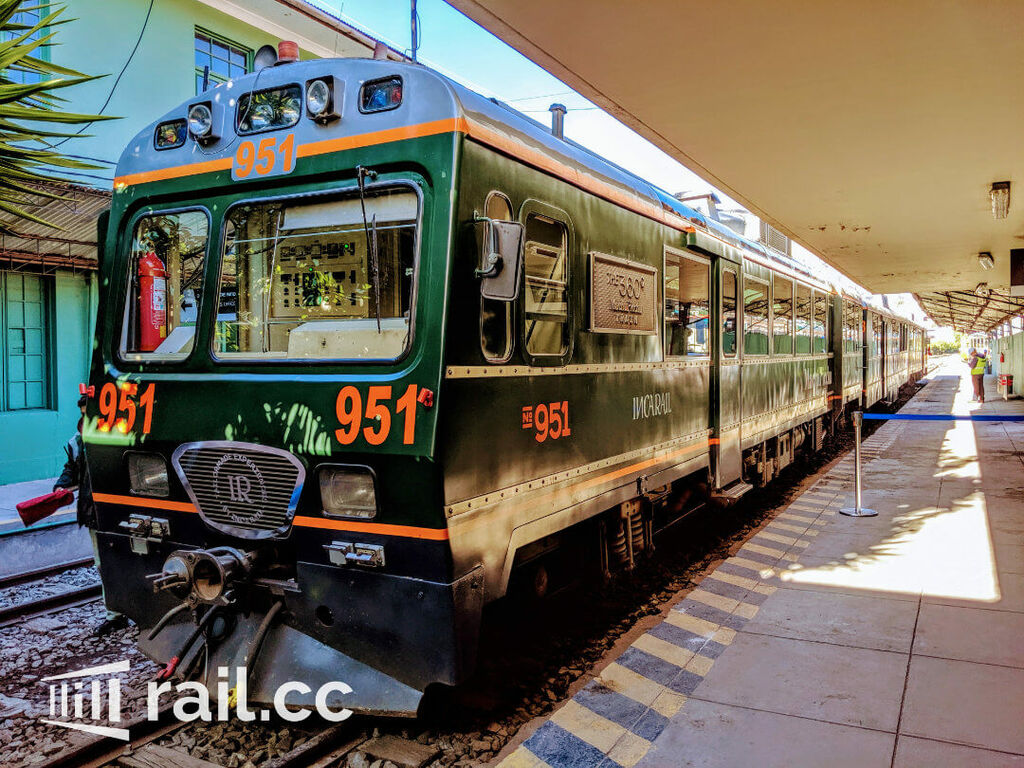
There are two main railway companies that offer a connection to Aguas Calientes: PeruRail and IncaRail.
PeruRail offers five types of trains that connect the Machu Picchu to the outside world and leave from Cusco, Urubamba or Ollantaytambo. One of them is the cheap local train, which is – sorry, smart spenders! – only for Peruvian citizens. Furthermore, there are four tourist trains; the Belmond Hiram Bingham luxury train, the Sacred Valley train, as well as the more inexpensive ones, the Vistadome and the Expedition train.
To make the confusion of which train to take perfect, there is another operator, IncaRail. IncaRail offers four different classes with various departure stations (Cusco, Poroy and Ollantaytambo). Those include two luxury trains, a private train to Machu Picchu (the only charter service!) and a First Class train, as well as two cheaper train services, the 360° and the Voyager.
So if you’re about to embark on this breathtaking journey to one of the 7 world wonders, you will have the ample choice between, believe it or not, eight trains of different classes and timetables. After all, I opted – not only because of financial reasons, but also because of IncaRail’s clear website and fancy design – for the mid-range segment: the very tempting sounding 360° train. In the following lines, I will tell you all about my trip with this train, my expectations and experiences. Have fun
Cusco
Cusco is undoubtedly a tourist hotspot – with justification. With its charming old town, countless restaurants for hardcore-foodies and coffee enthusiasts, boasting with Inca culture, being the doorstep to Machu Picchu, Cusco is definitely worth a trip. You can arrive either by plane or bus. But be warned. If you’re coming by bus from Lima, you will have to brace yourself for a 21-hour bus journey. One-way flights from Lima or Arequipa with Sky, Latam or VivaAir start around only €22 (cheaper than the bus!), if you’re booking early. If you are more spontaneous, like me, and opt for the bus, Cruz del Sur is the go-to company. From Arequipa to Cusco, it was “only” 10 hours in the night bus (which are very comfortable and even offer an on-board service). Generally, one could say, that in South America, it is always a good idea to check flight prices first.
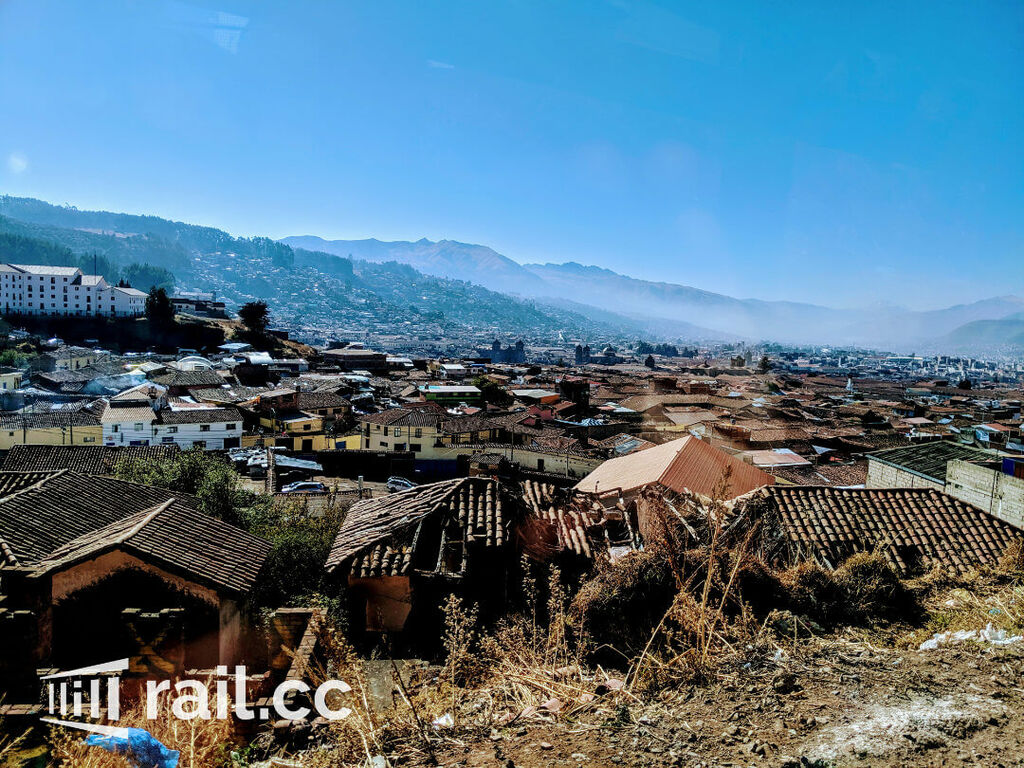
Cusco from above
No matter how you end up there, almost anyone to arrive will have trouble breathing at first. After all, the city lies at nearly 3.400 m above sea level. A great excuse to spend a couple of days there to acclimatize (even if Aguas Calientes and even Machu Picchu lie lower). There surely is enough to do and see. If you’re up for a great burger lunch, I can recommend Chakruna Native Burgers (with fries made of 5 different kinds of potatoes and a drink included).
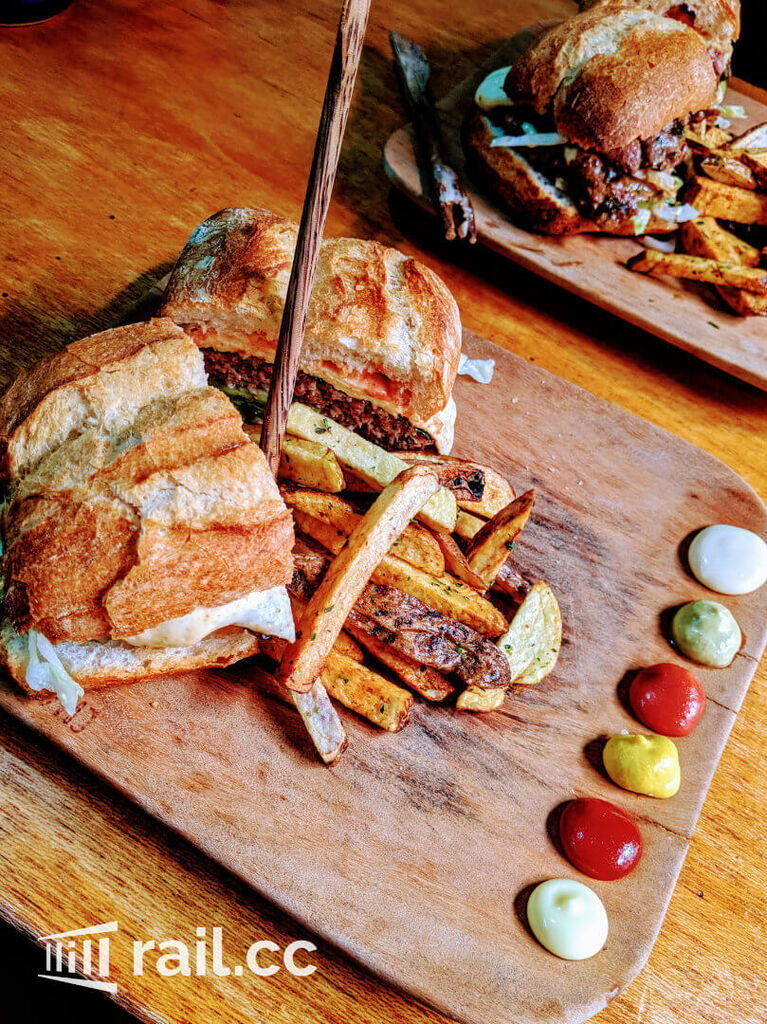
Burger Lunch at Chakruna Native Burgers
In Cusco, I stayed in the Xplora Hostel. A fairly new hostel, located about 15 minutes by foot to the Plaza de Armas, the main square. I chose this place not only because of its stylish interior. It also offers a beautiful view over Cusco’s rooftops and is also located 15 minutes by foot from the San Pedro train station (even if a taxi within town only costs 5 Soles – €1,35). I received a warm welcome and my suite was spacious and clean. Breakfast is being served between 7 and 10 and consists of coffee or tea, cornflakes with yoghurt, as well as butter, marmalade and a breakfast bun. Unfortunately, the coffee was already sweetened and the cornflakes were pretty stale, but altogether the hostel offers good value for money and a very cosy atmosphere – I can recommend it (you can always have breakfast elsewhere…)!
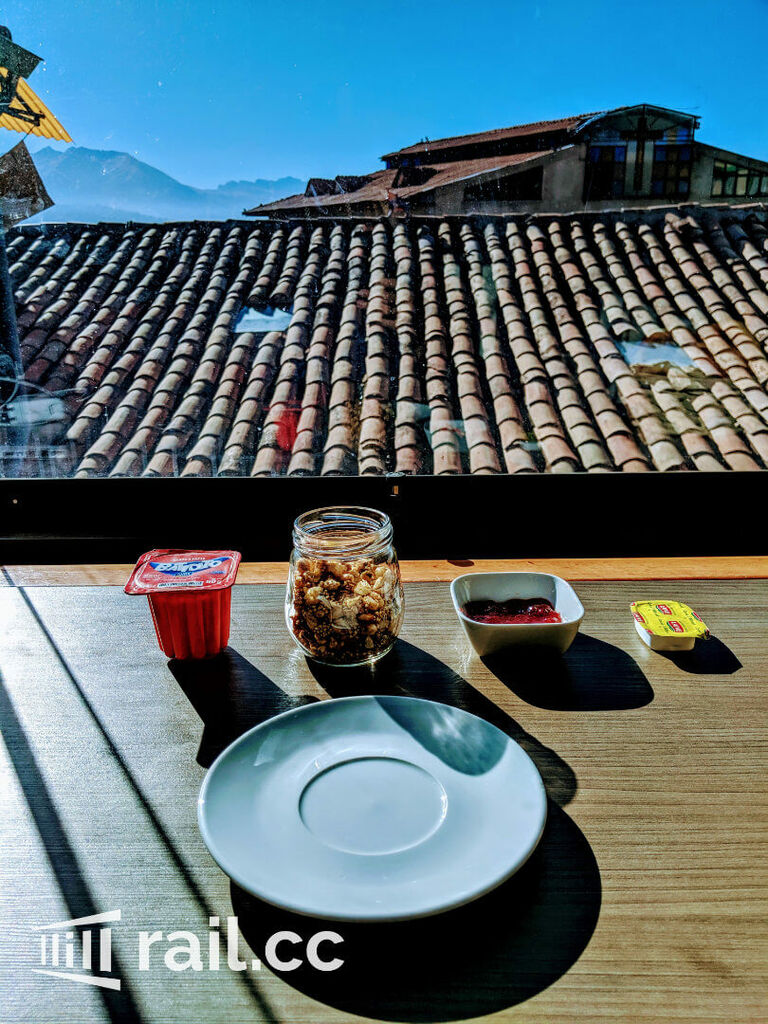
Breakfast with a view
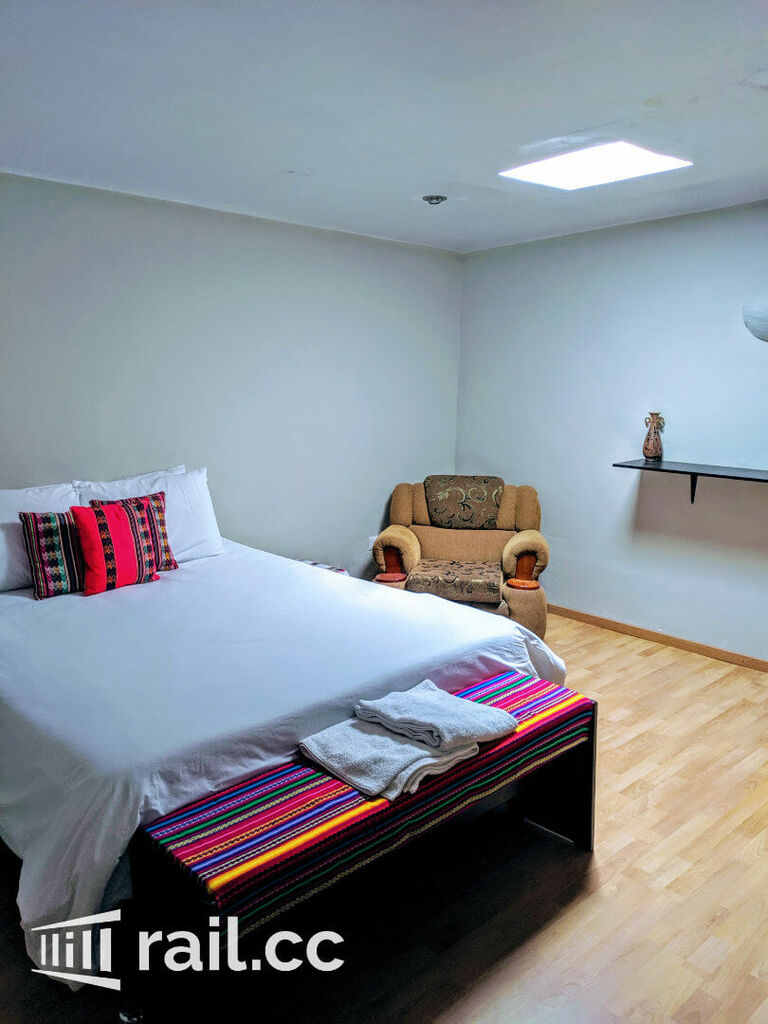
My room at the Xplora Hostel
Train classes and “bimodal trip”
As mentioned before, IncaRail offers 4 different train classes, which I briefly want to describe here. All prices account for a one-way trip from Cusco, San Pedro station. There is no discount for a return trip. For the most recent prices, I generally recommend visiting IncaRail’s website.
1. The Private
The “Private” offers travellers an exclusive charter service. You will get a private wagon, a champagne reception, a gourmet meal, a private bus to Machu Picchu and a more than exclusive interior with live music. You’ll receive prices upon request, but in my opinion, it will be an amount in the four- to five-digit range.
2. The First Class
In the First Class, you will also receive a gourmet menu, an observatory lounge bar, live music and a private bus to the citadel. Prices for a one-way trip start at around €195 and up.
3. The 360°
The medium-price range 360° attracts passengers with an outdoor observatory wagon with a connecting bar, extra large panoramic windows, a box lunch and In-train-entertainment. I chose this train, which is why there will be more infos about prices under “tickets and prices for the 360° from Cusco”.
4. The Voyager
The Voyager is cheapest of all IncaRail trains, which doesn’t make the trip any less special. It offers standard panoramic windows, snacks, hot and cold drinks, as well as background music. For a one-way trip, you will pay €71, which is not much cheaper than the slightly more expensive 360°. You can find more in-depth descriptions, photos, timetables and additional information about the train classes on IncaRail’s website.
The bimodal journey
Apart from the mere train ride, IncaRail also offers a slightly cheaper journey, that starts in Cusco (Av El Sol 843) by bus, which brings you to Ollantaytambo, where you will board the train to Aguas Calientes. The travel time on the bus is around 2 hours. The bimodal trip is only being offered for the 360° and the Voyager and was by my time of booking only €3 cheaper that the direct train from Cusco, San Pedro, which made the decision really easy.
Tickets and prices for the 360° from Cusco
As mentioned before, the 360° belongs to the middle class of trains offered by IncaRail. Depending on your time of booking and departure train station (in my case, Cusco, San Pedro), you will pay between €78 and €108 for a one-way trip. The peculiar thing is, that people, who book very far in advance usually pay more (€99) than the spontaneous ones (€78). Of course, then, it can’t be guaranteed, that you will get a spot on the train of your choice on the day you’d like. So after I went through the sheer variety of trains and made my decision, I simply booked the train online. Unfortunately, I was not able to choose my seat, yet. Promptly after paying via credit card, I received an email containing my “purchase voucher”, asking me to exchange it for my real ticket at any IncaRail office. Shortly after that, I received another email, containing a ticket pdf. As it turned out, I could have simply printed it myself. More about that under “IncaRail Office”.
Timetable and train stations
With IncaRail, you have three different departure stations to choose from: Cusco, Poroy and Ollantaytambo. Out of sheer laziness and to be able to enjoy the longest train ride possible, I quickly opted for the Cusco station. The San Pedro station in Cusco has only just been reopened for trips to Machu Picchu in March/April 2019 and is located in the heart of the city. Be careful, though: It’s not to be confused with the “Estacion Wanchaq”, which still seems to pop up first, once you google for a Cusco train station. But worry not; as soon as you go and get your ticket at the IncaRail office, you will receive additional information, like directions to the station near the Plaza de Armas.
From Cusco, there are eight daily connections to Machu Picchu with three different train classes (excluding the Private). On Sundays, timetables differ. The First Class leaves at 08.28 and arrives in Aguas Calientes at 12.41. The 360° leaves Cusco at 05.00 and 08.43 and arrives in each case at 08.48 and 13.06. The Voyager departs at 08.28 and reaches Aguas Calientes at 12.41. Furthermore, there are also four bimodal trips: with the 360° at 10.16 and an arrival time in Aguas Calientes at 14.00, and with the Voyager at 04.10, 08.40 and 16.15, with arrival times at 08.01,12.41 and 21.09.
For the most recent timetables, especially at the weekend and holidays, I recommend you to check IncaRail’s website. Please always pay attention to the correct departure station.
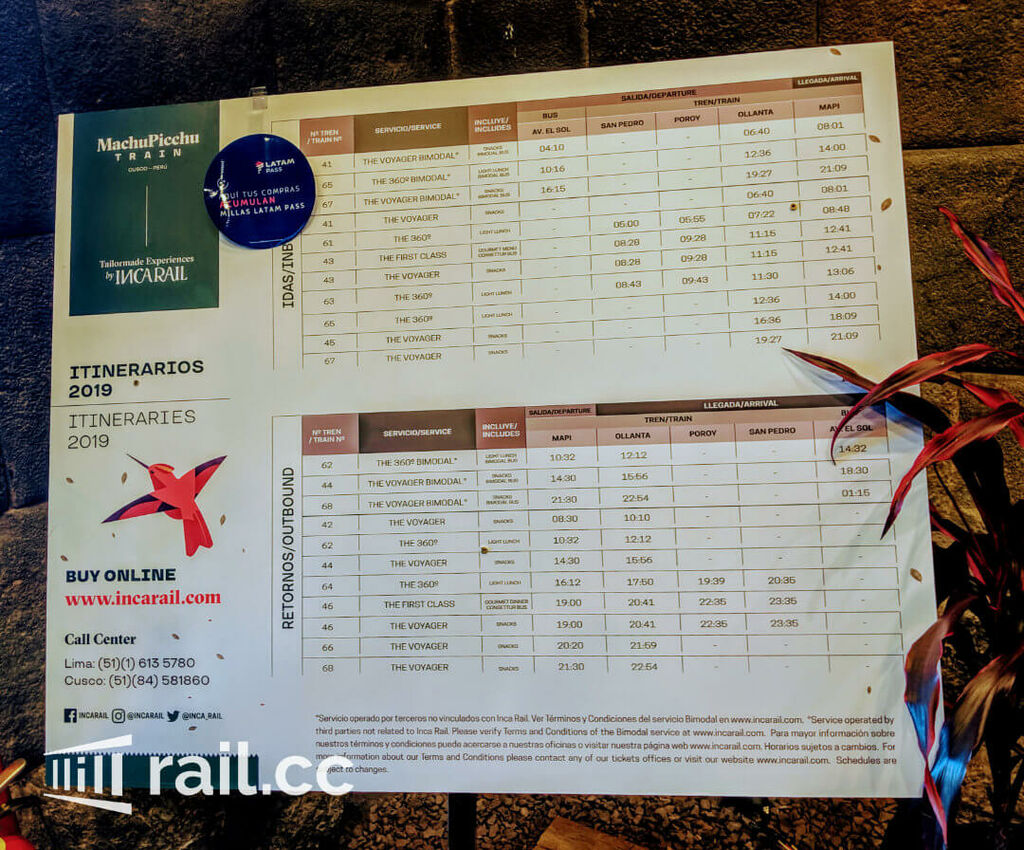
Timetables
The IncaRail office
The main IncaRail office in Cusco is located directly at the Plaza de Armas. Every tourist will pass by it at least once during his visit in Cusco, so it’s no inconvenience to swing by and get your ticket organized. The office looks extremely modern and very new.
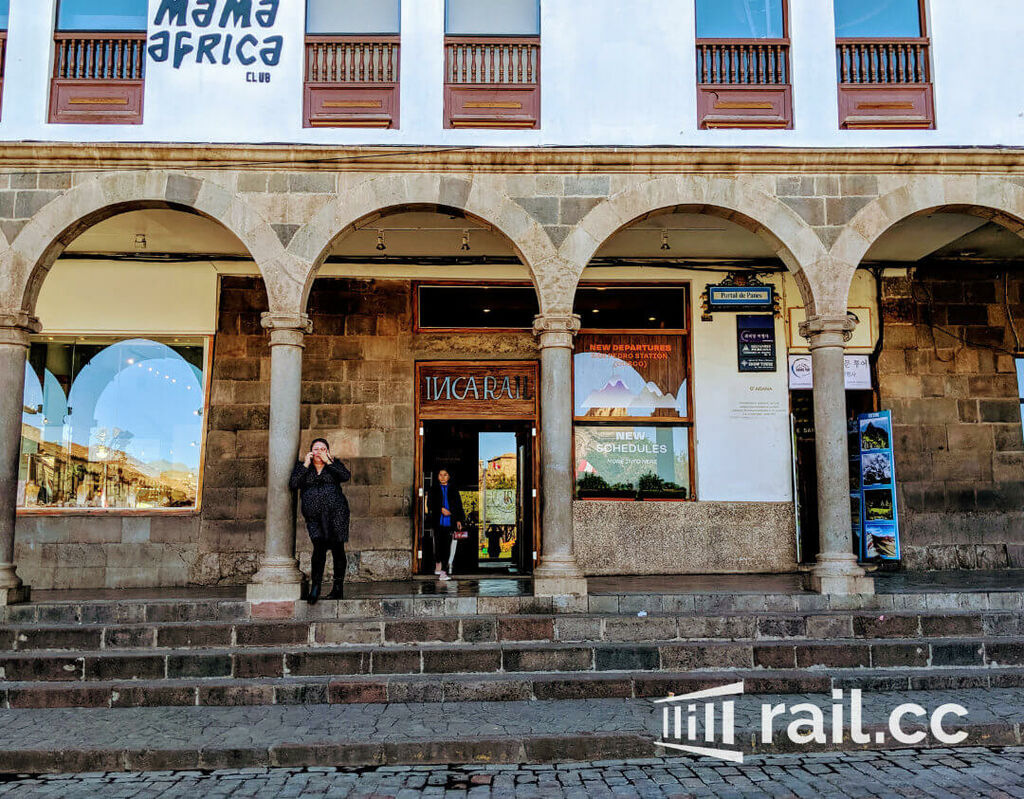
The IncaRail office from the outside
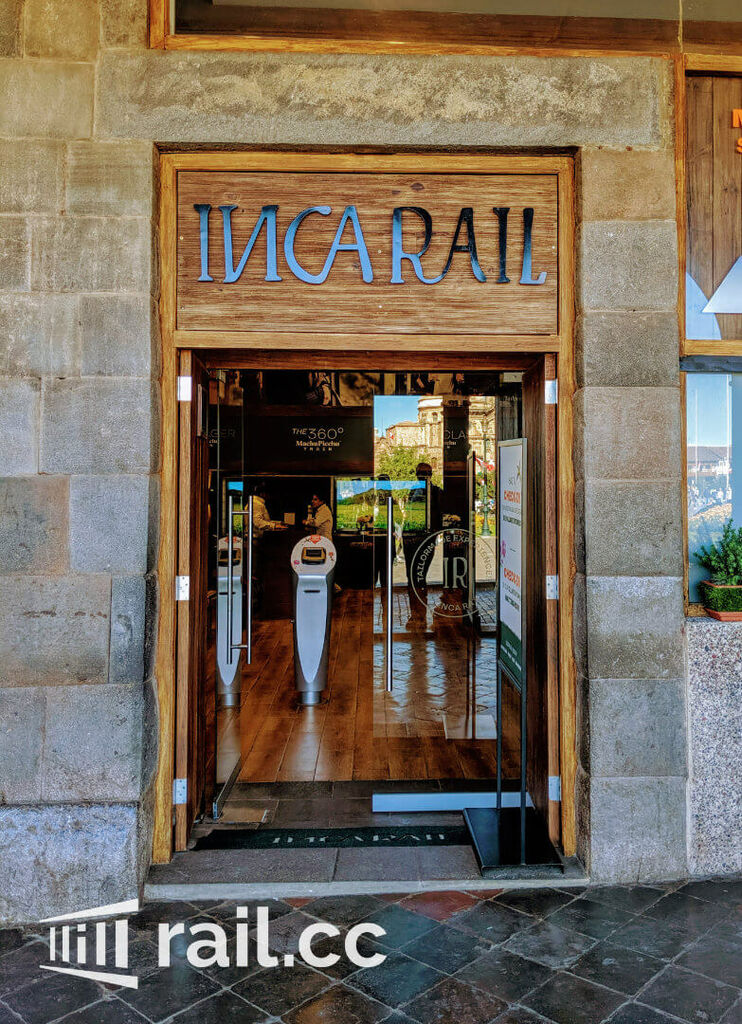
Office entrance
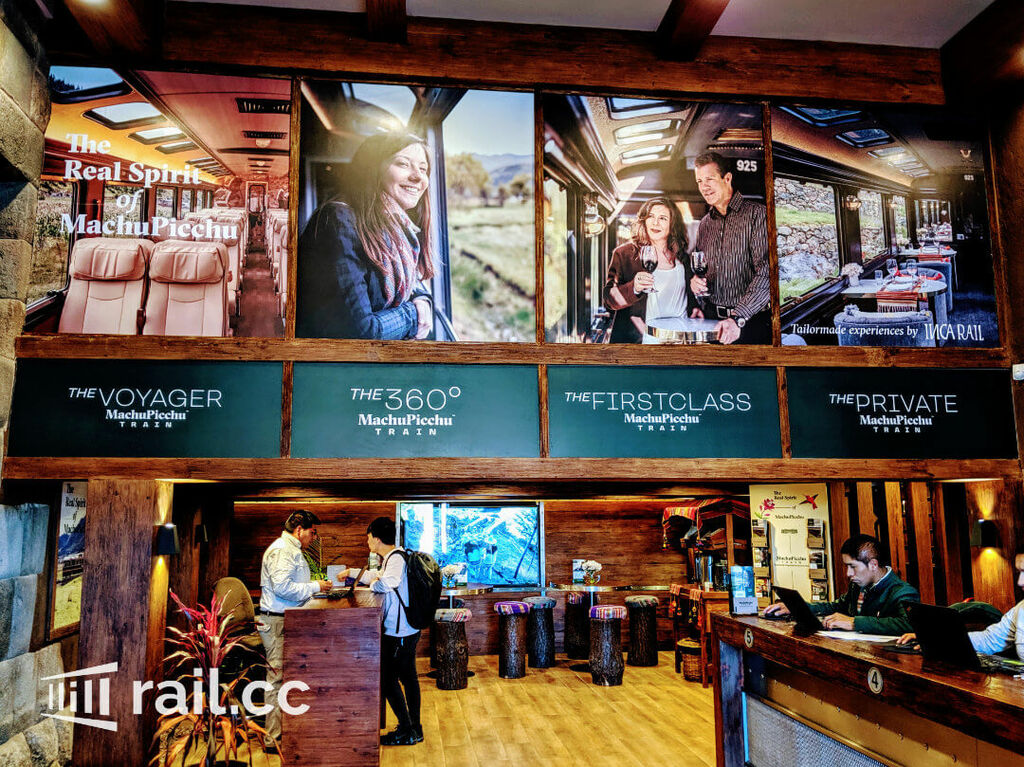
Inside the IncaRail office
Right after entering the building, I was greeted in English by a friendly employee. Generally, one seems to have to pick a number to be served, but since there was nobody else but me in the office, I was served straight away – even without a number. After showing him my email with the ticket-pdf, he briefly took my phone and explained, that it would take a few minutes to print, so I would be very welcome to have a look around and grab a tea from the tea station. No sooner said than done, I made my way to the very pretty visitor’s corner, which was apparently made with a lot of attention to detail and offered a broad spectrum of different teas to choose from – among the coca tea, helping with the altitude – a comfortable sitting area and more information materials.
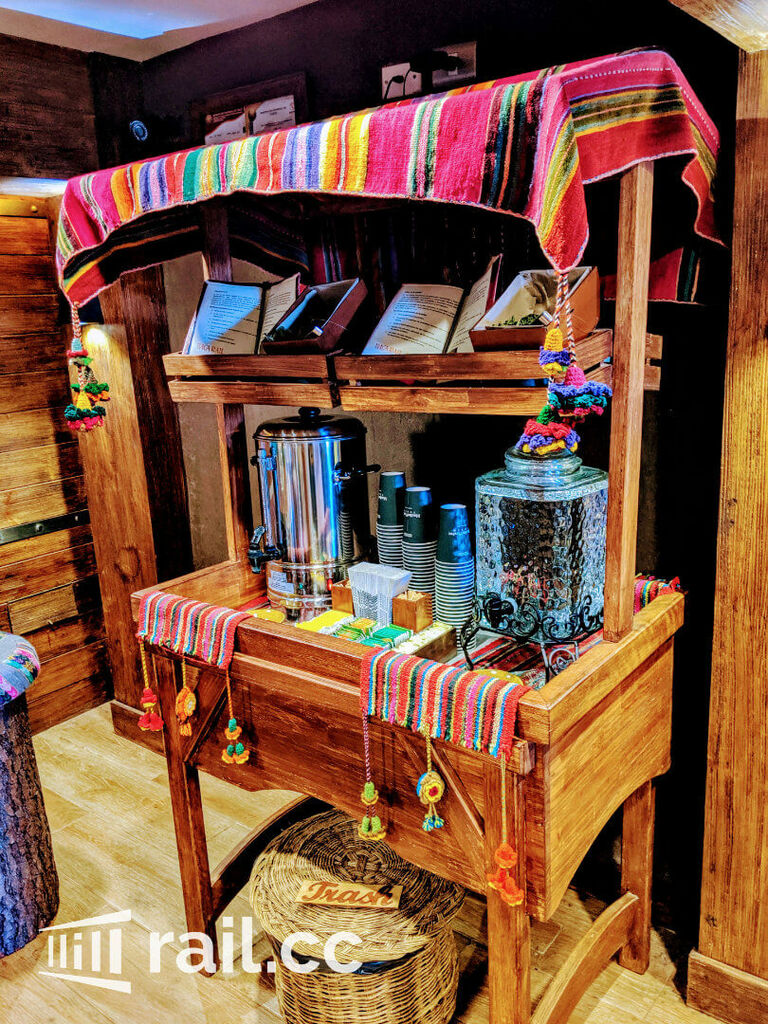
Comfy tea corner in the IncaRail office
Quickly, my ticket was printed – of course, for free. Apart from that, I was holding two very helpful, high-quality flyers with directions to San Pedro station and more information about the train, in my hands. Unfortunately, I forgot to ask for picking my seat. It may be possible, that you will have the chance to pick your own seat if you ask. He wished me a nice ride and I left the office.
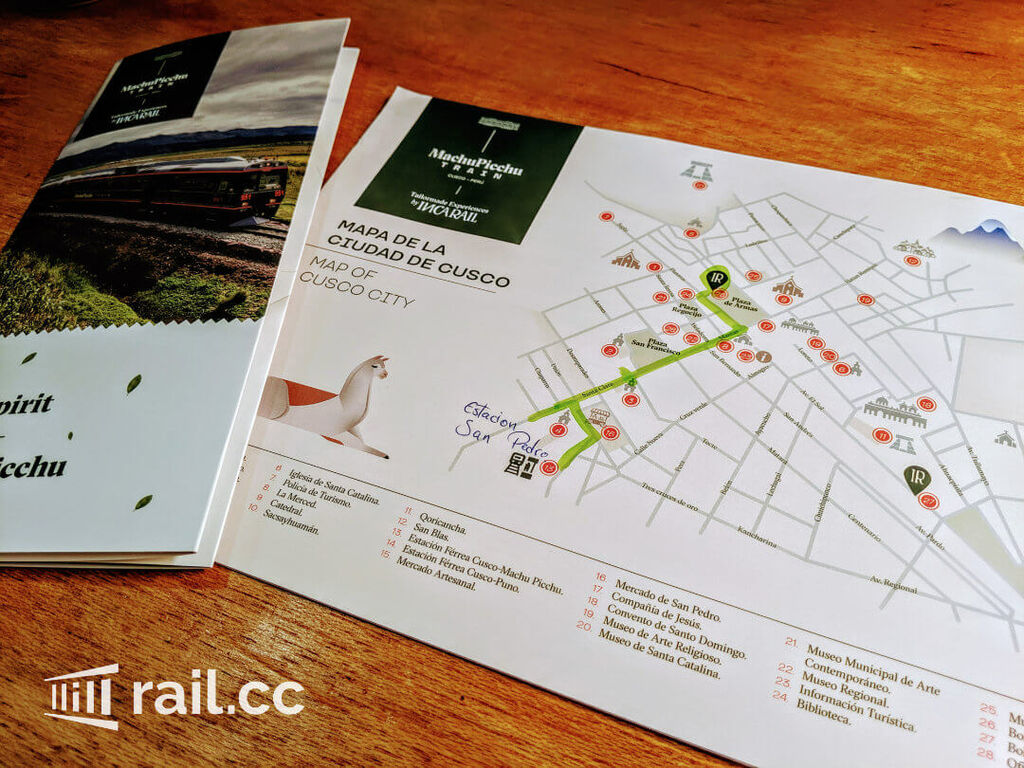
Directions to San Pedro Station
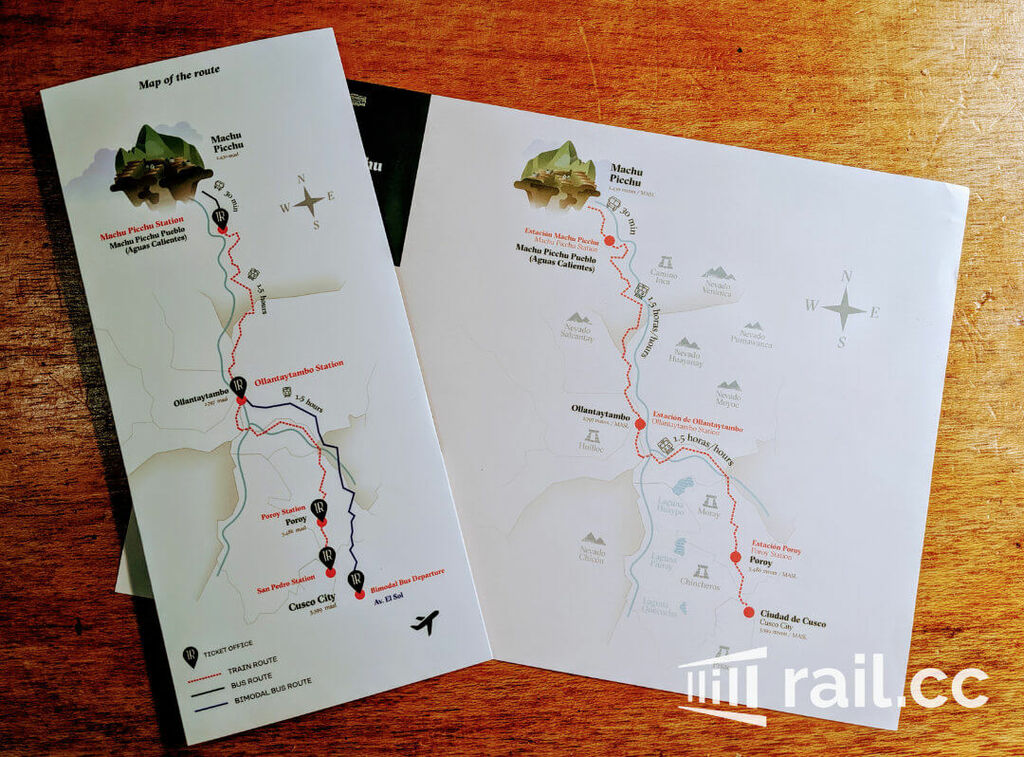
Map of the route
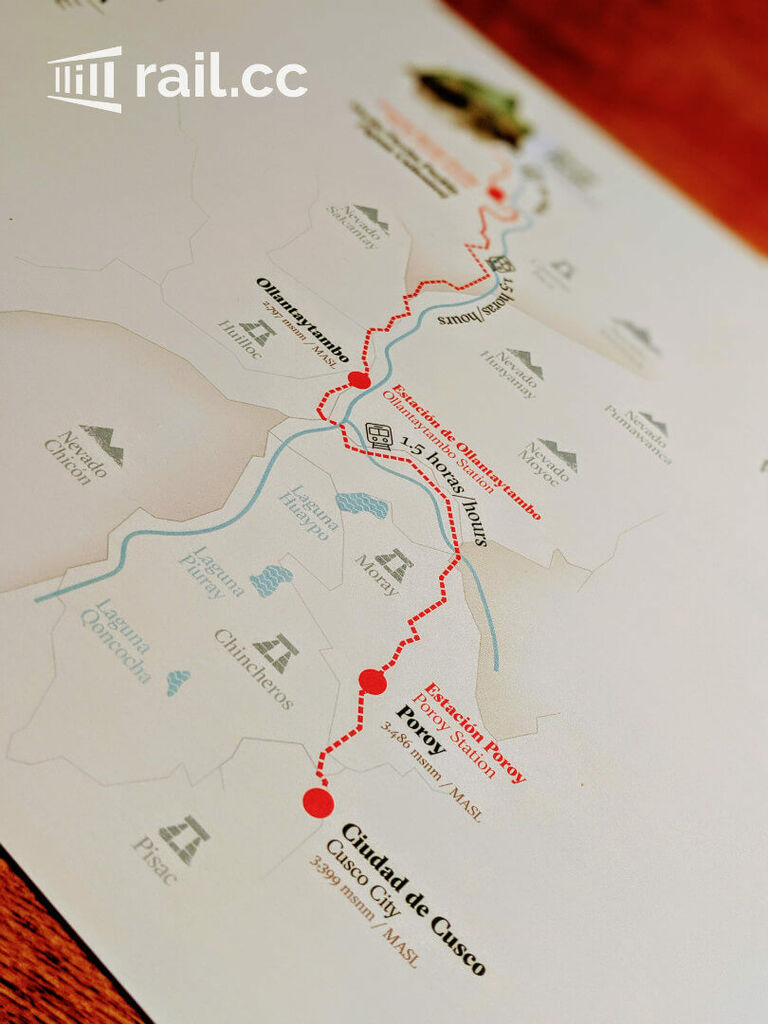
detailed route
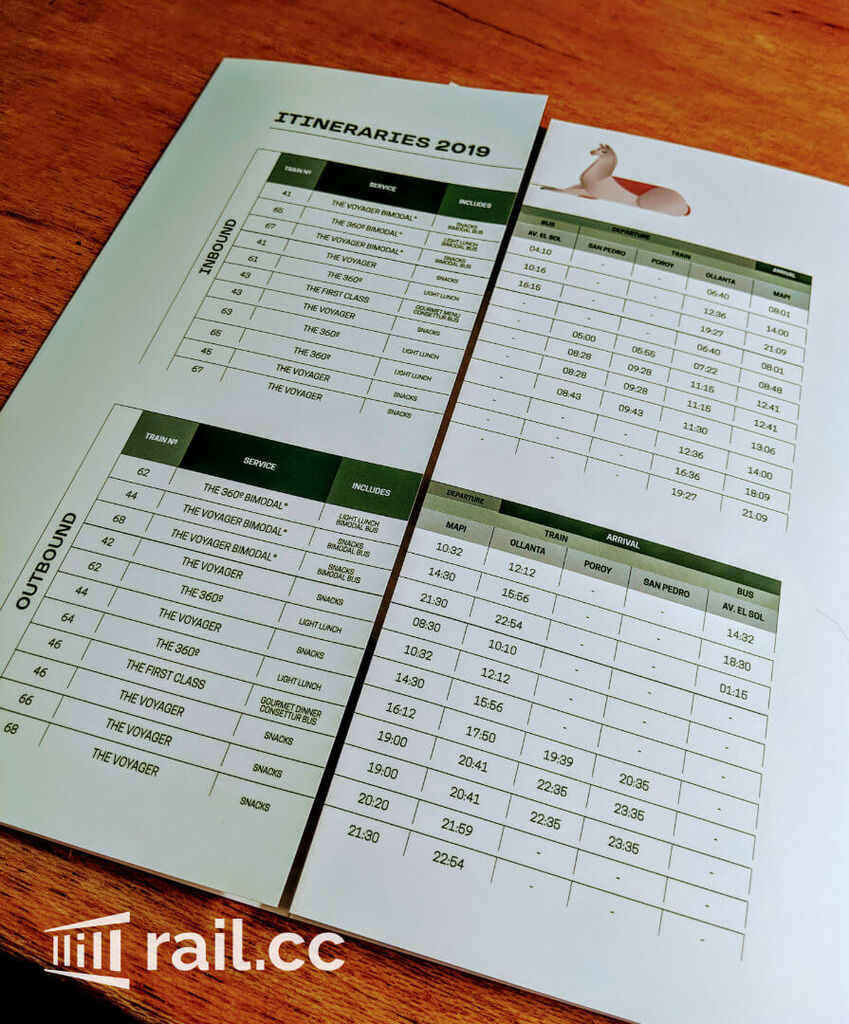
Timetables
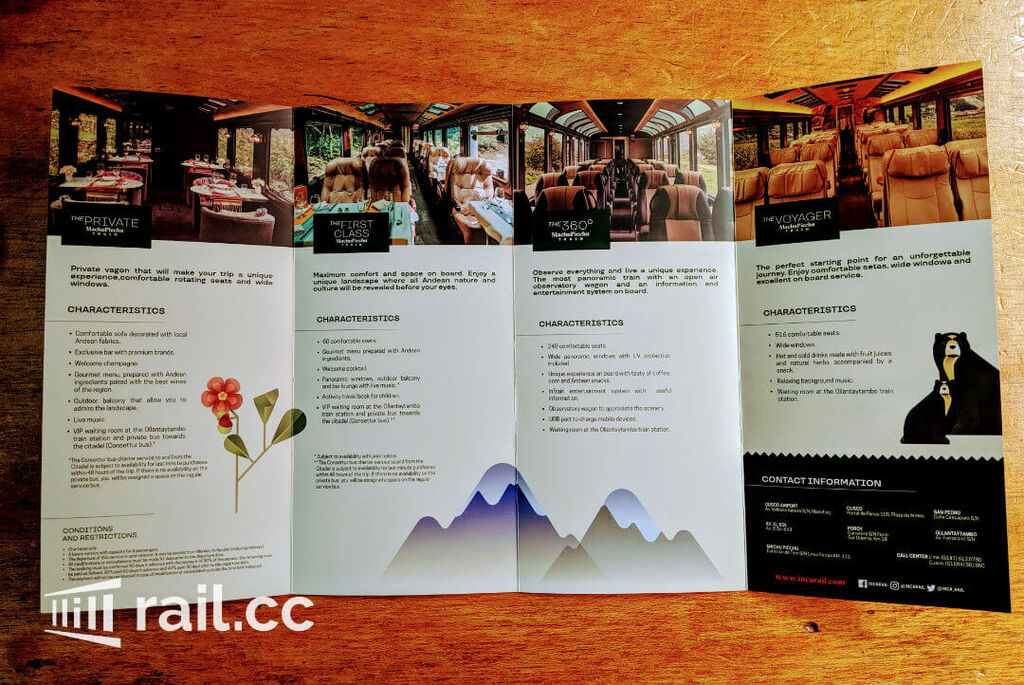
The different trains
Departure from Cusco San Pedro
I woke up to my alarm at 7. Having more than enough time until departure at 8.43, I have breakfast first. It is mandatory to arrive at the station 30 minutes before departure. Unhurriedly, I walk to San Pedro station, which is located right across the San Pedro market. In contrast to the IncaRail office, the station looks pretty run down from the outside.
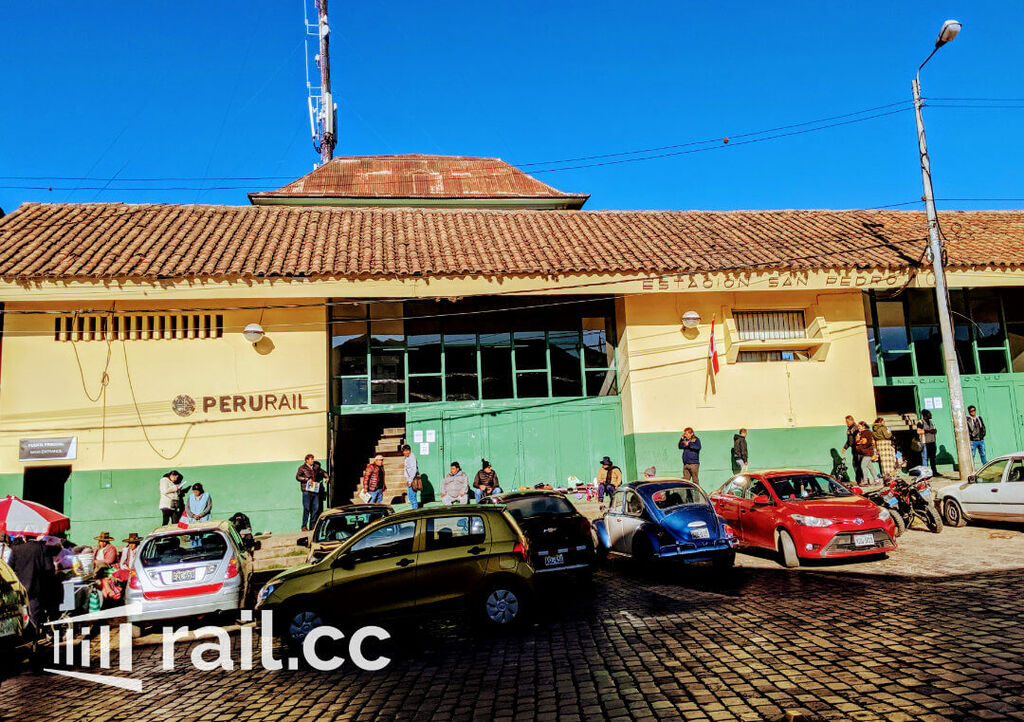
San Pedro Station from the outside
It is quite obvious, that it hasn’t been used for quite some time and now only serves as a means to an end (compared to other train stations on our planet). IncaRail shares the building with PeruRail, which becomes apparent, because of their two ticket counters, squeezed right next to each other. There are two separate waiting halls for the two companies. To get to the IncaRail waiting area, you have to enter to the platforms first and turn to your right, where the hall is located; a sign leads the way.
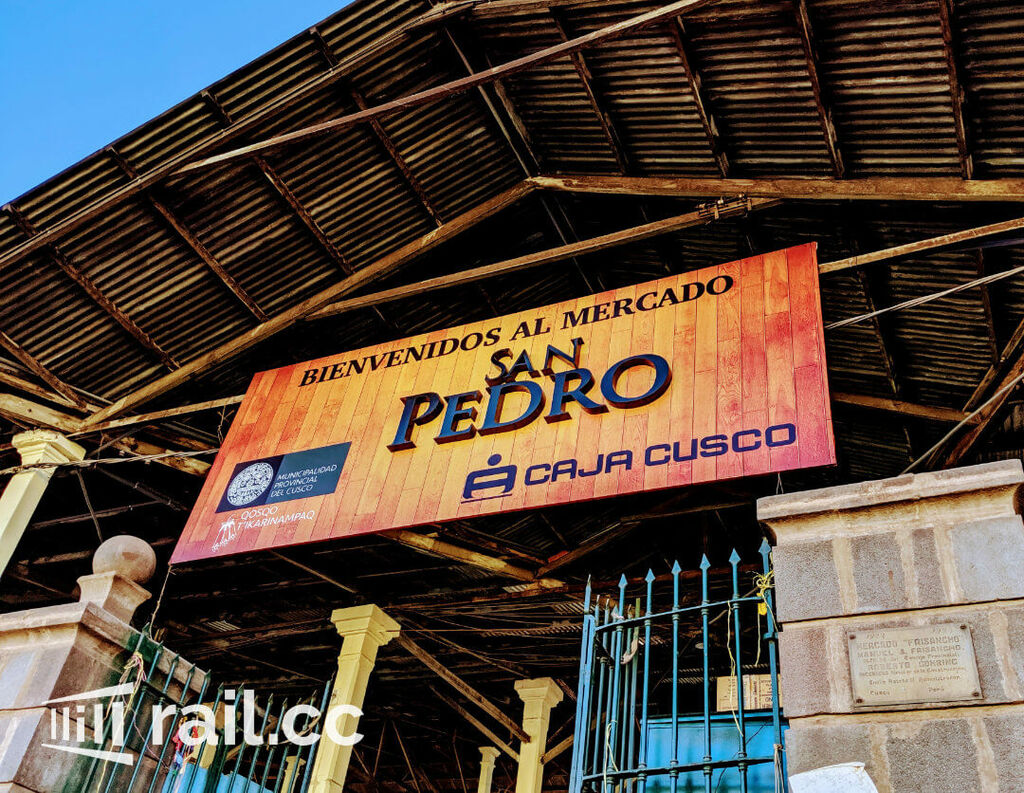
Entrance to San Pedro Market
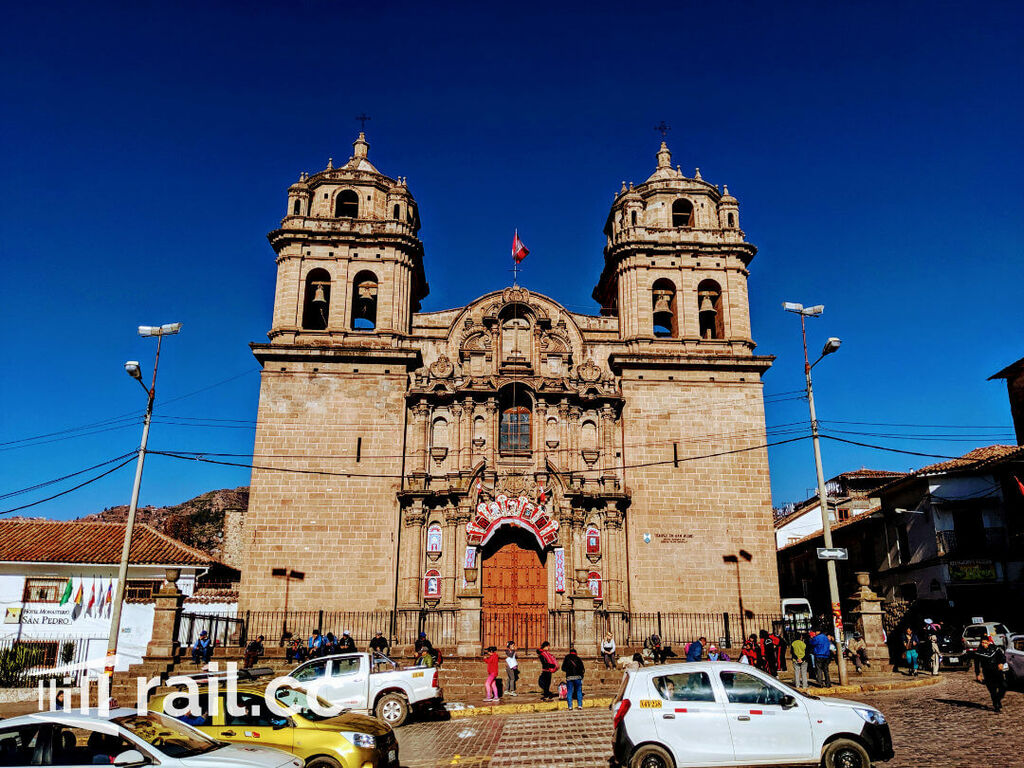
Church next to the station
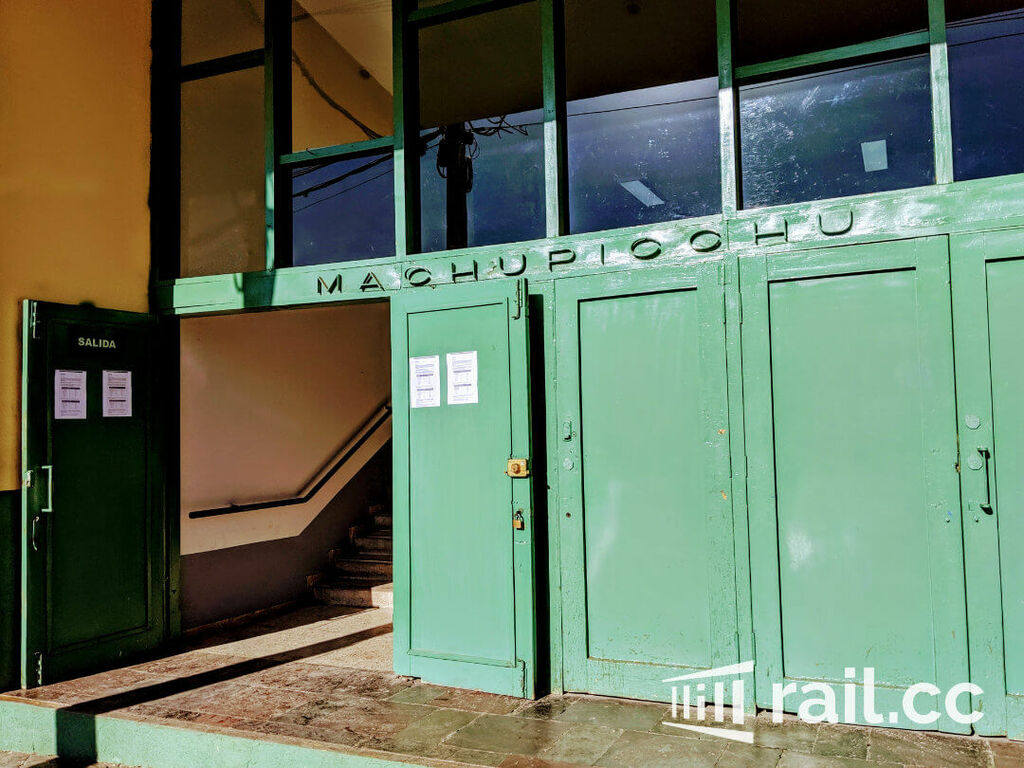
Entrance to San Pedro Station
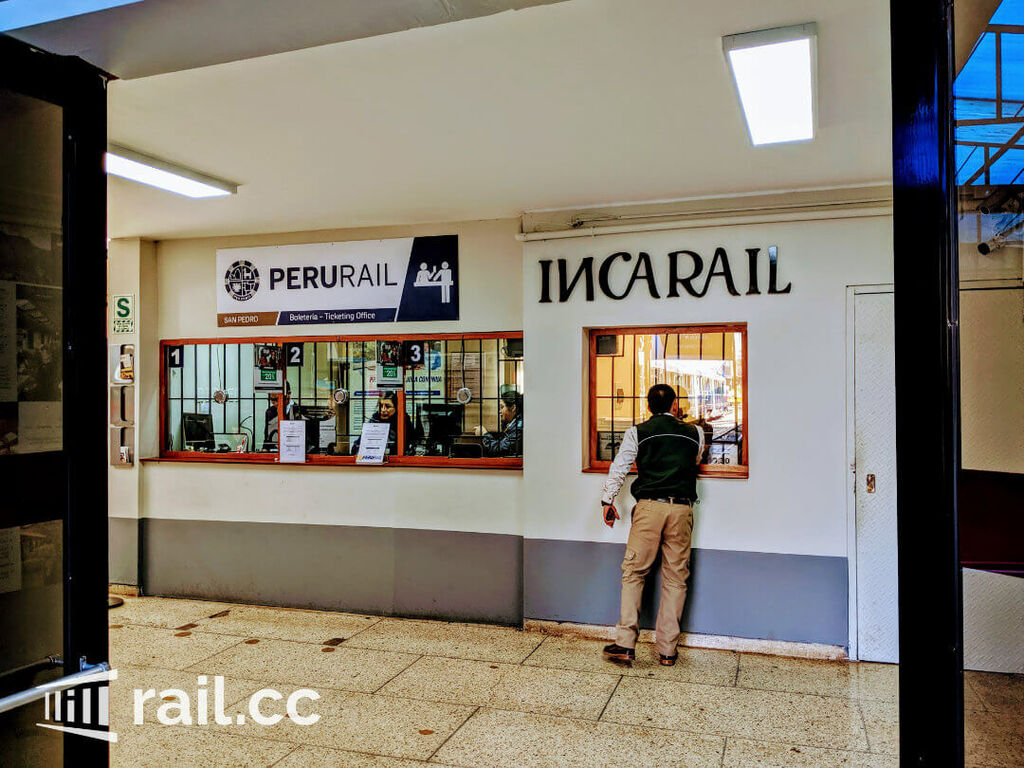
PeruRail and IncaRail ticket booths
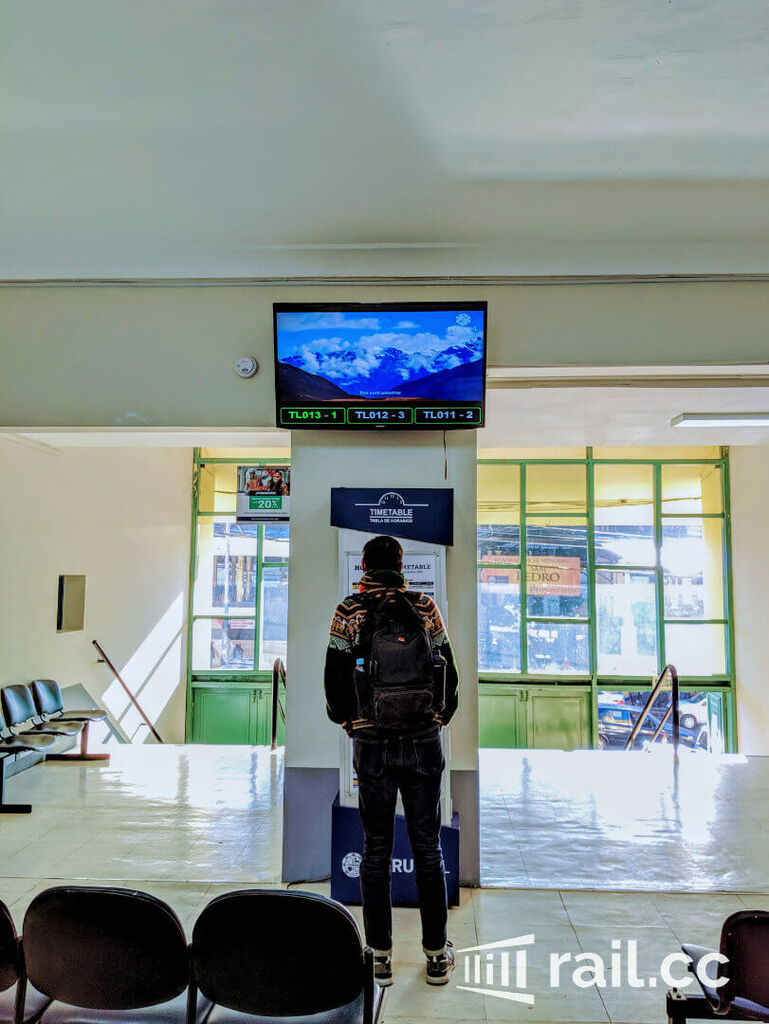
PeruRail waiting hall
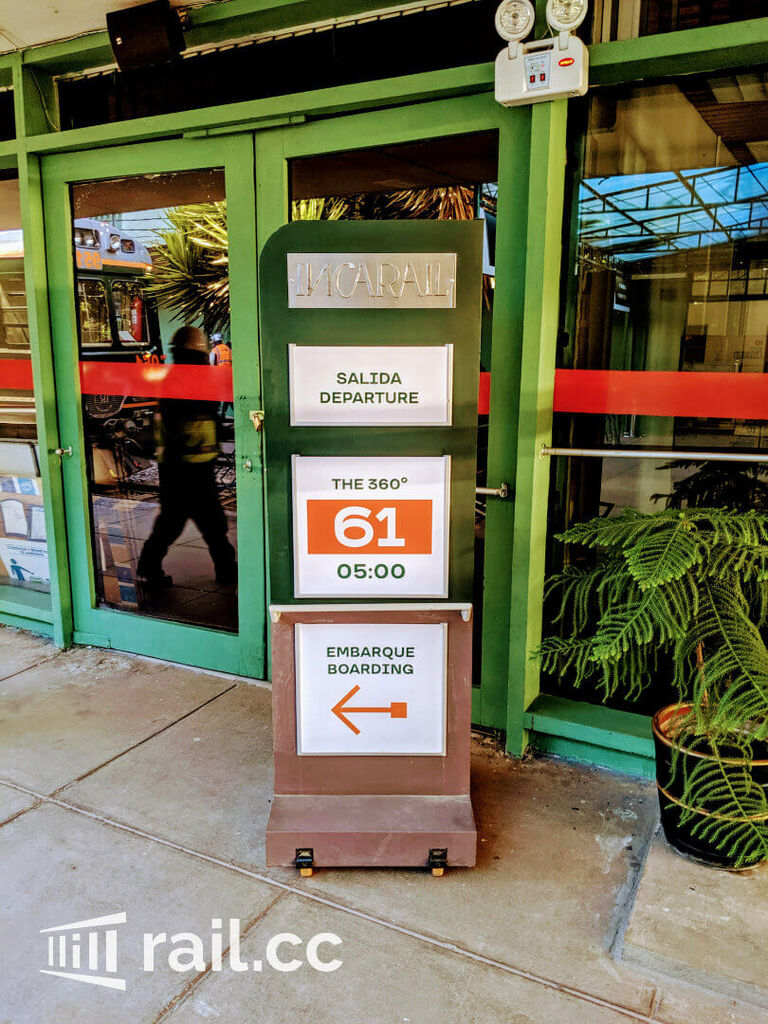
Entrance to IncaRail waiting hall
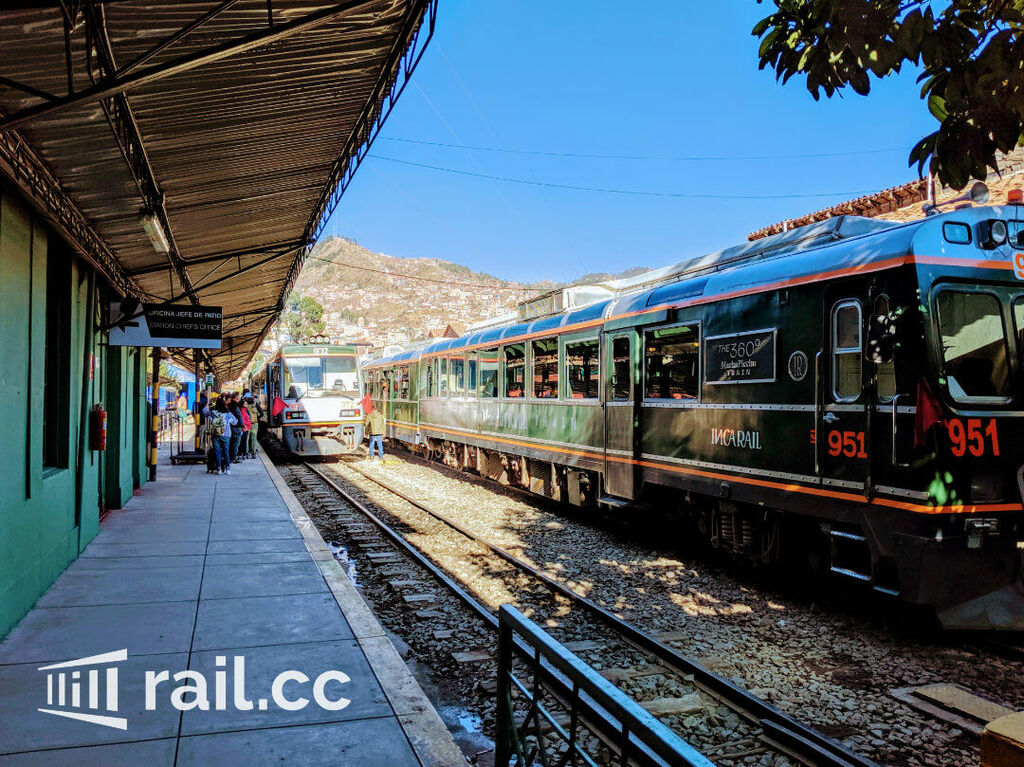
PeruRail’s “Voyager” waiting on the platform next to IncaRail’s “360°-Train”
If you have some time to spare, you can have a look around San Pedro market and maybe even buy some extra snacks for the trip. There, you can find pretty much anything you might be looking for – except for unsweetened coffee. 30 minutes before departure, I dutifully enter the waiting area, which is equipped with a couple of benches and a bathroom. The dark green, polished train is already waiting on the platform and the usual hustle and bustle has already started.
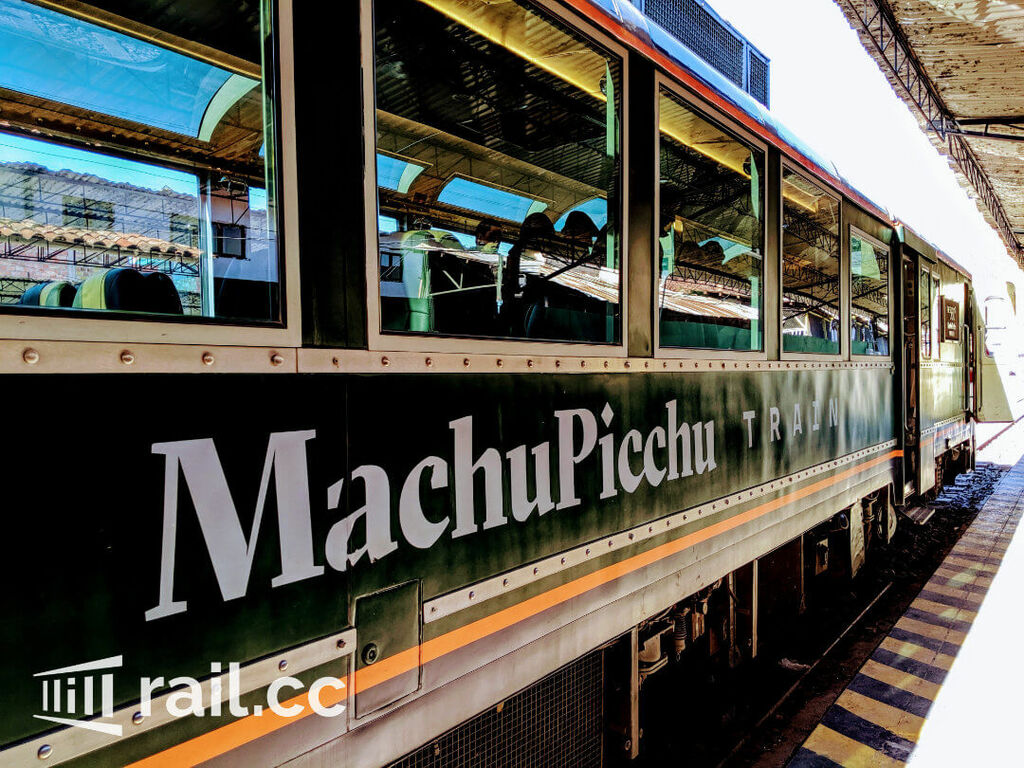
The 360 waiting at the station
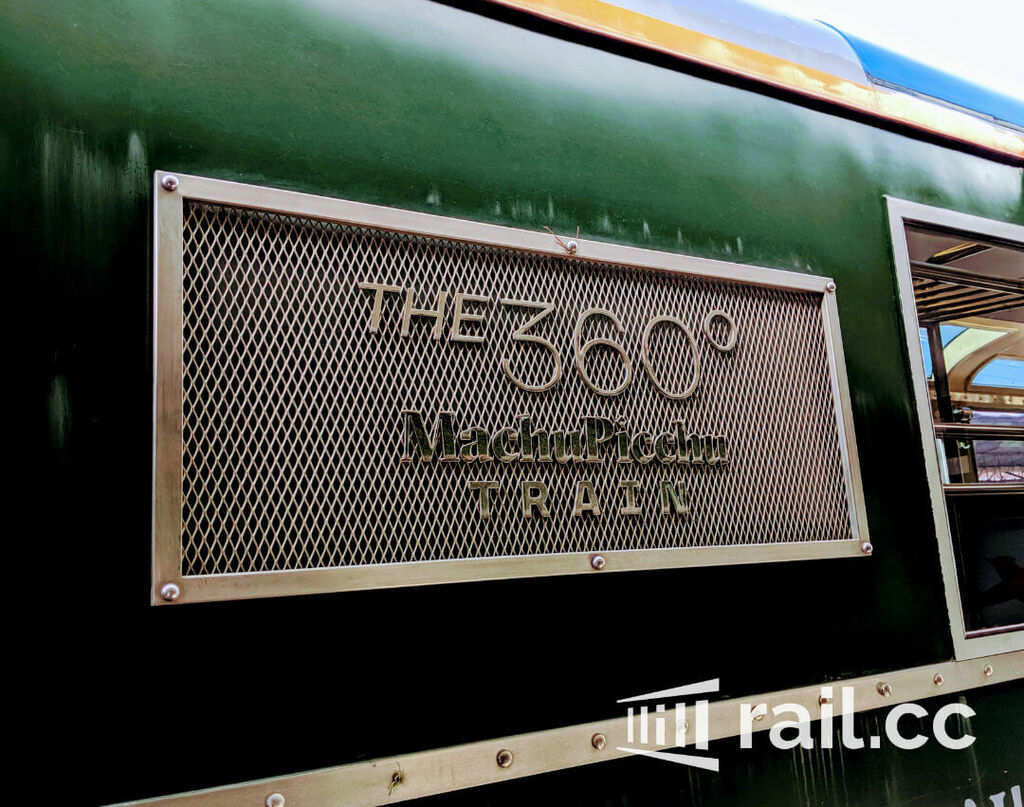
Detail of the train plate
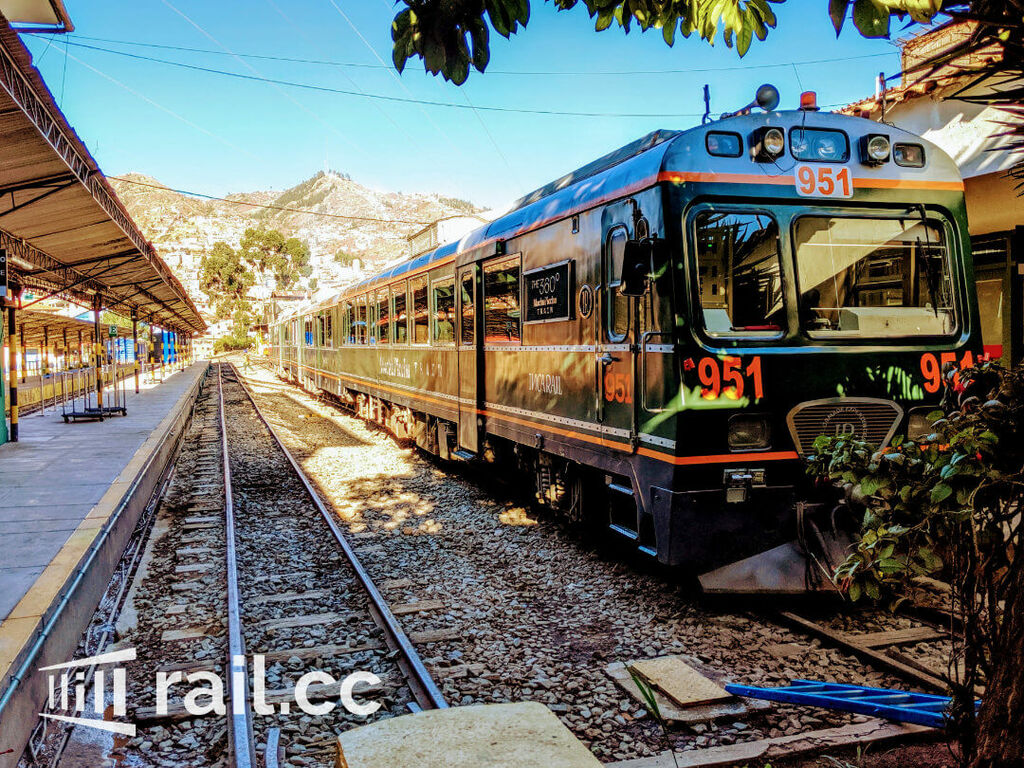
The train from the other side
About 10 minutes before departure, everybody suddenly become a little restless and start getting ready. There was no announcement, but apparently, an employee positioned herself at the entrance to the waiting hall and asked the passengers to get ready. I am slightly confused, since the train number on my ticket doesn’t correspond with the one on the train. I show the nice lady my ticket, just to make sure. She nods and points me to the end of the train. There is already a queue, where a train attendant is collecting the printed tickets and points out everybody’s seat.
The train
The train is filling up quickly, my carriage is – apart from very few seats – completely full. I’m in luck, it seems I ended up getting a window seat after all. The interior is quite modern and new, yet a little tight. Immediately, I recognized the extra large and very clean panoramic windows, that even have an additional, smaller window above the normal one (where you can usually find the luggage rack), to deliver a clear view on the mountains. The grey, artificial leather seats are slim and come in pairs of 2. The 2x2 seats are separated by a grey foldaway table and offer one power plug and two USB-plugs, so you can – theoretically – work or charge your phone during your ride. Unfortunately, on my seat, only one USB-plug is functioning (so no work for me!).
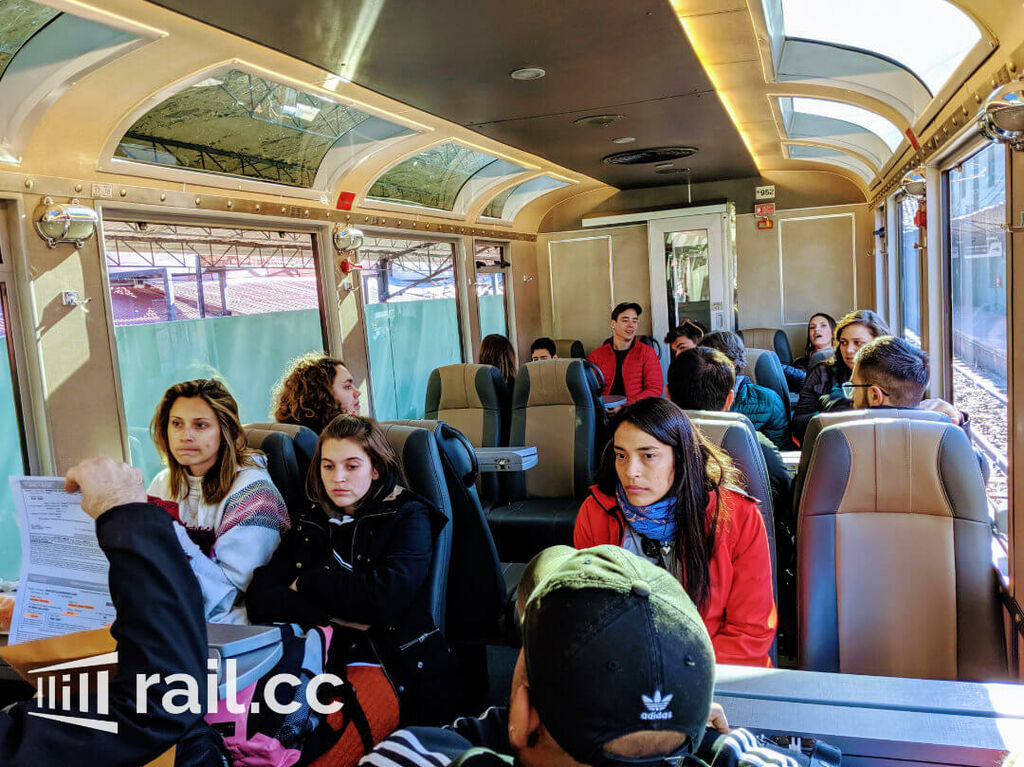
Train interior
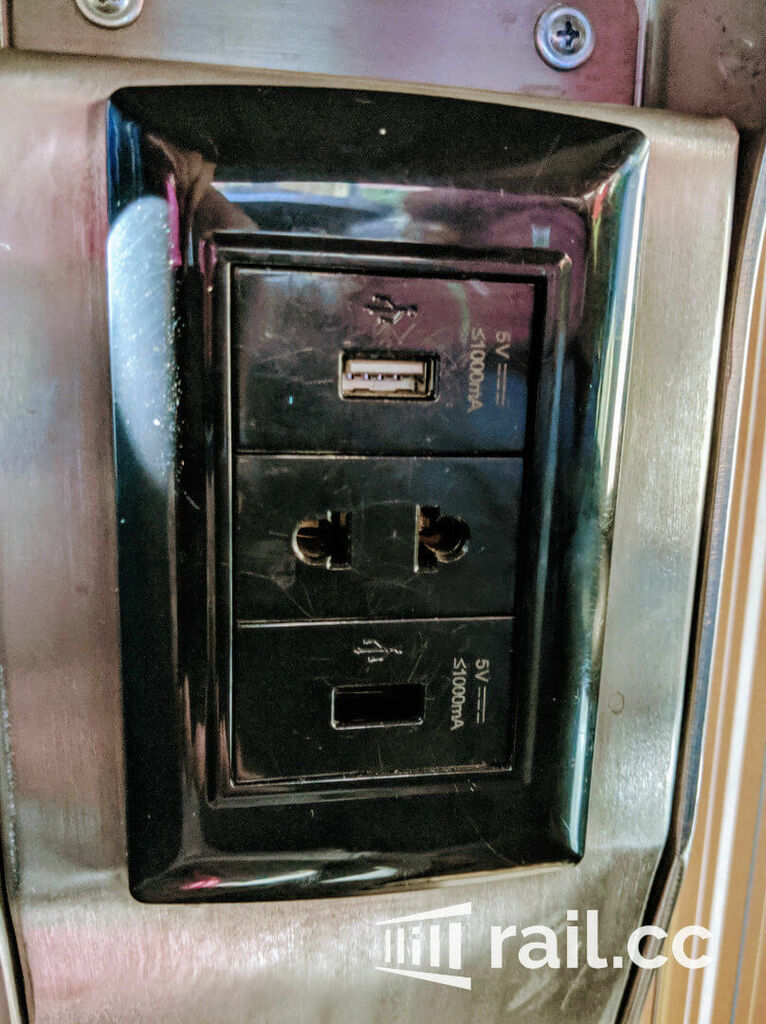
Power socket and USB-slots under the table
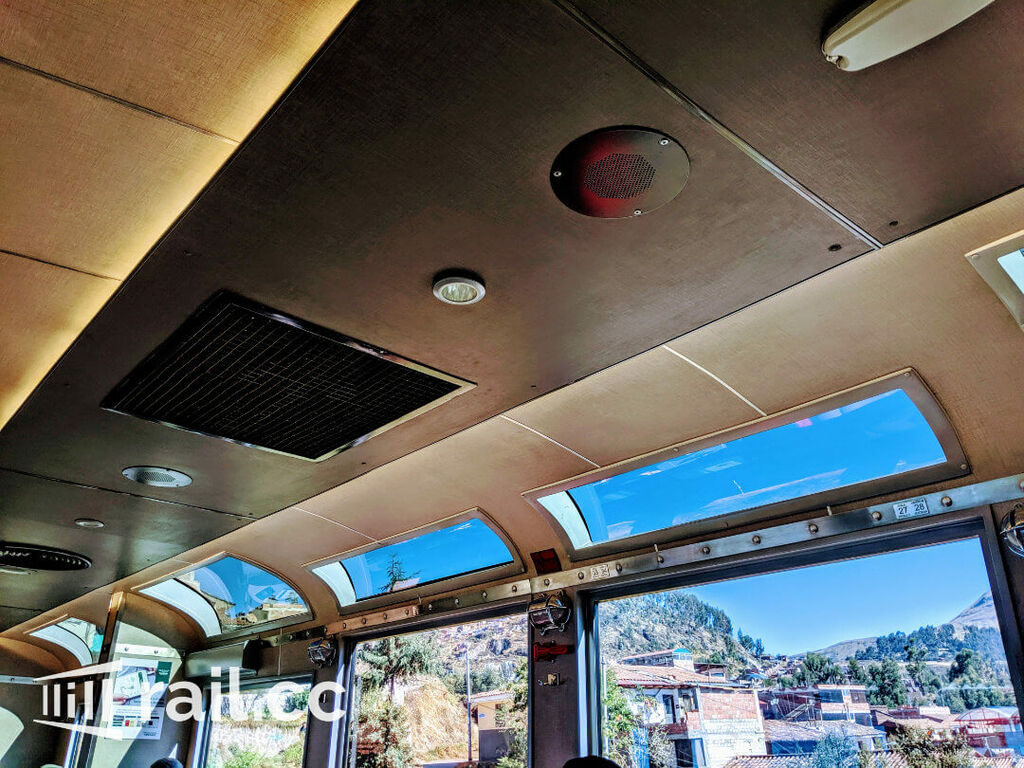
Panorama windows
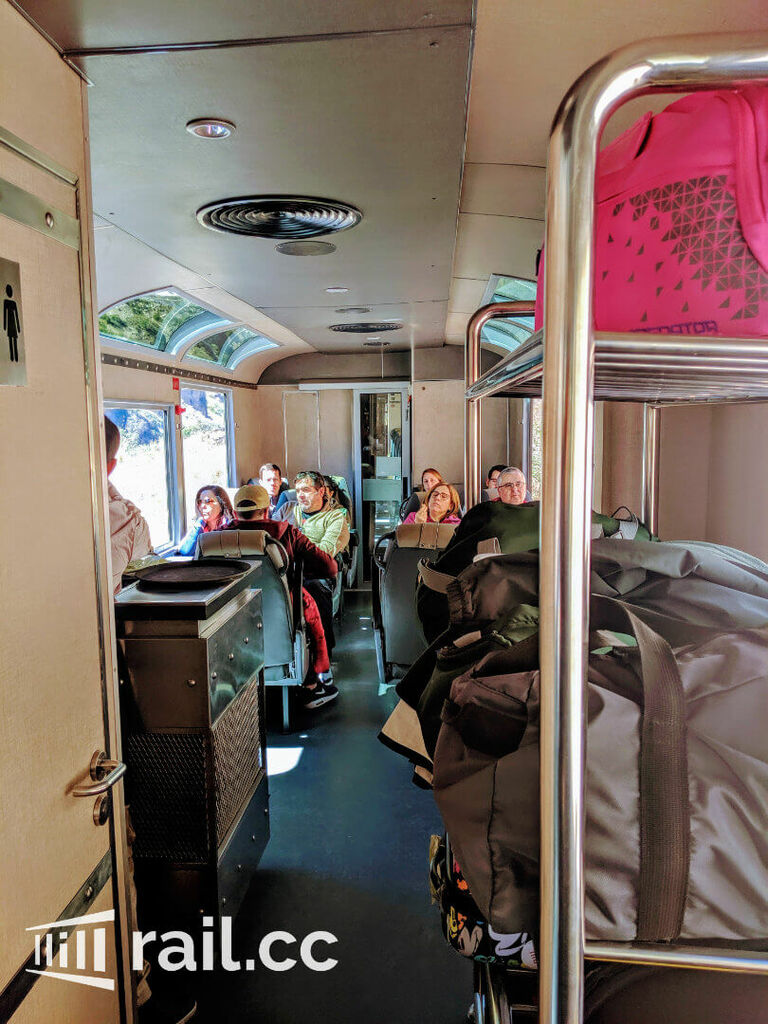
Inside the train
At the entrance of the wagon, there is a small luggage storage, as well as a toilet, which has toilet paper and soap at your disposal and makes a very clean impression. Be aware: the red button next to the toilet is, according to its label, an emergency button and mustn’t accidentally pressed to flush (as it happened to some of my fellow passengers – by the way, nobody came for help). In order to flush, you will find a black button, ON TOP of the fitting.
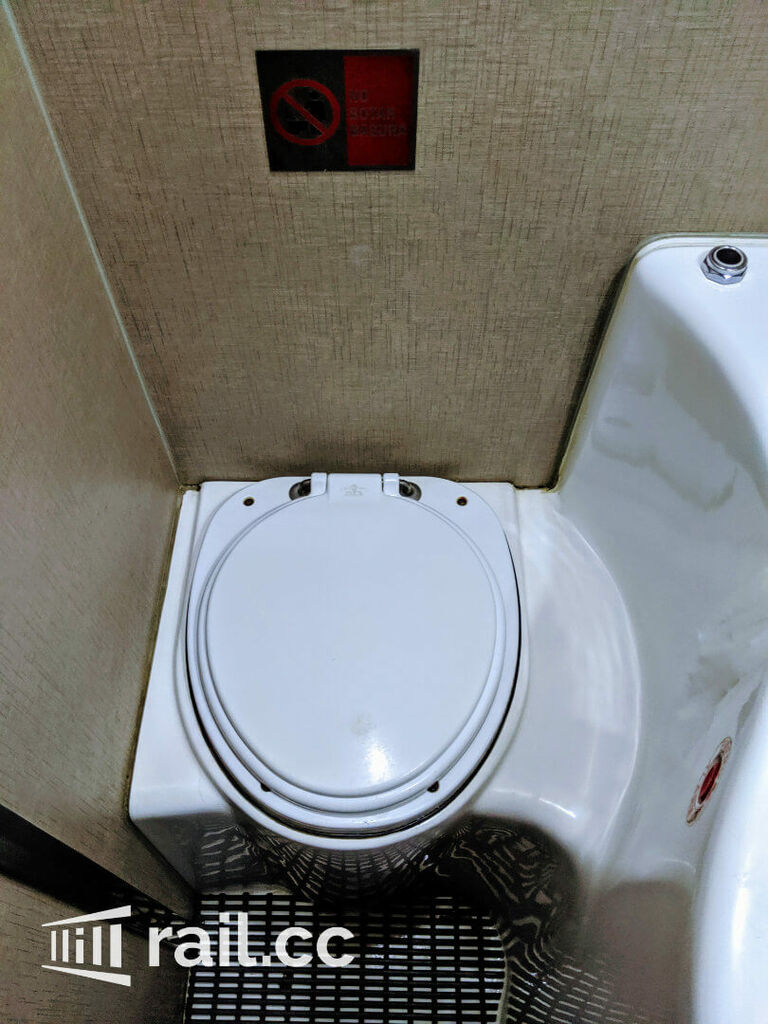
Toilet with black button to flush on the top right
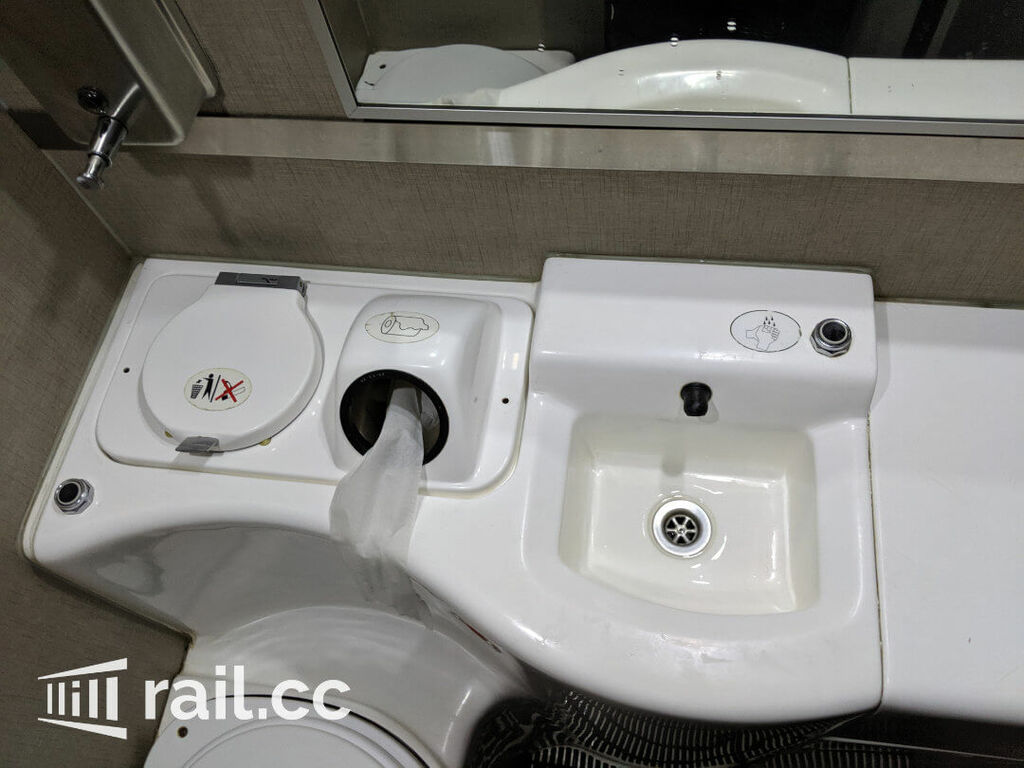
Basin with soap and toilet paper
One last thing there is to say about the luggage storage is, that officially, it is not allowed to bring large luggage pieces, like suitcases or big backpacks, into the 360° (I would guess, mostly, because of the lack of space). But don’t worry, seemingly it will be overlooked, since most passengers only bring hand luggage anyway, so that there is, in fact, enough space for a few big bags.
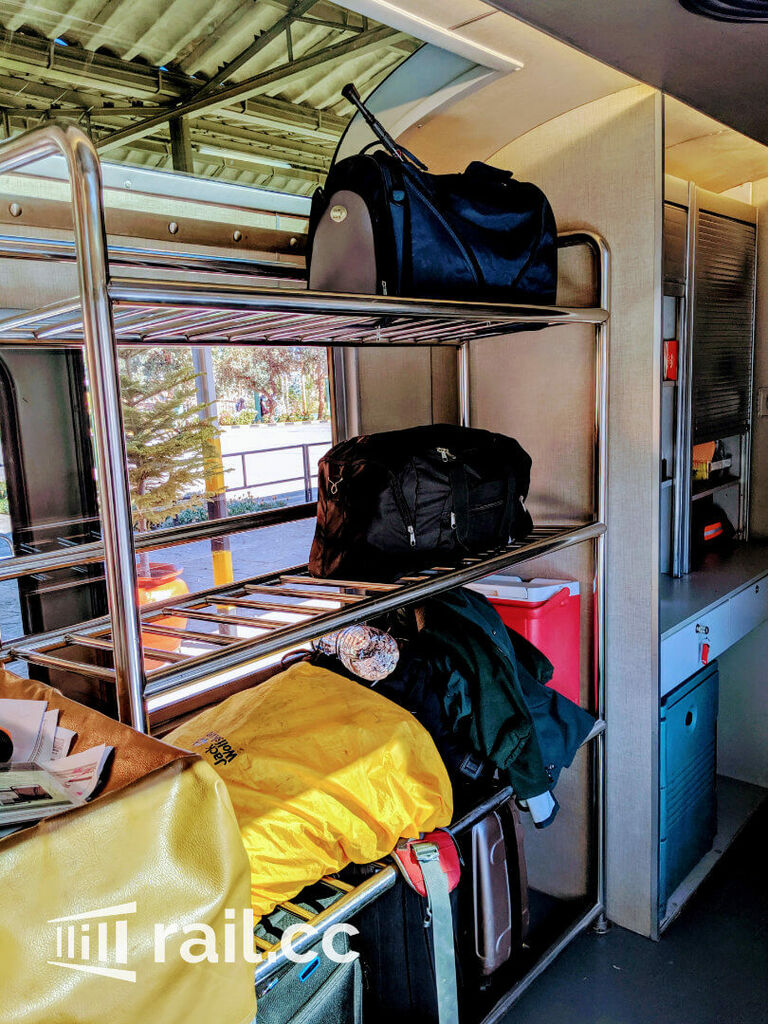
Small luggage storage at the entrance
After all passengers found to their seats, the train departs at 8.43, perfectly on time. We receive safety instructions through the train attendants and I almost feel like I’m on a plane! Once the instructions are over, I use the time everybody else needs to get comfortable, to have a little look around.
In the observation wagon
So here we are in one of the best-selling points of the 360°: the observation wagon. It is usually located in the middle of the train and has even bigger windows that the seating area. Well, actually, it doesn’t have windows at all. The observatory wagon is pretty much completely open so that you can enjoy the views while being able to take pictures without any annoying window flares. Safety first, of course: there is a handrail, that keeps you from leaning too far out of the window – I almost feel like I’m in a roller coaster. The observatory wagon is smaller than the seating area and fills up quickly. Means, you have to know soon enough, when you want to go there, in order to get the best view. Well, you can always use your elbows (just kidding!).
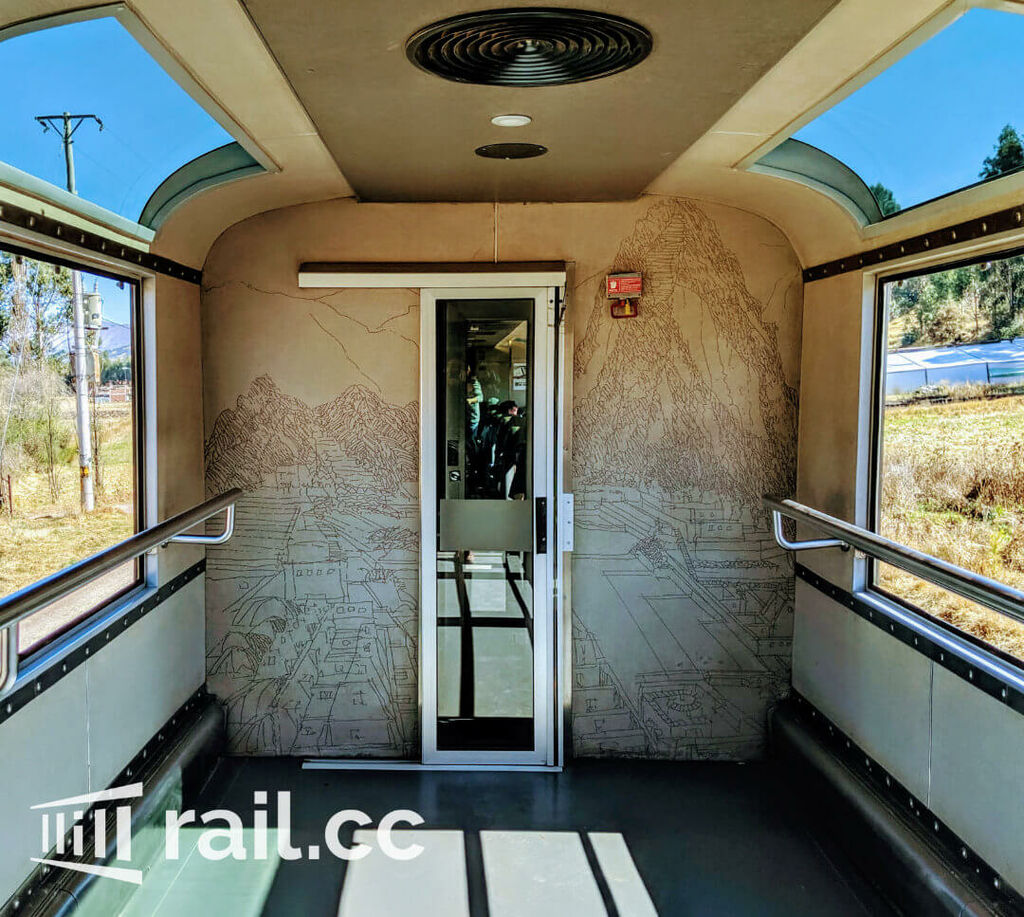
The observatory waggon
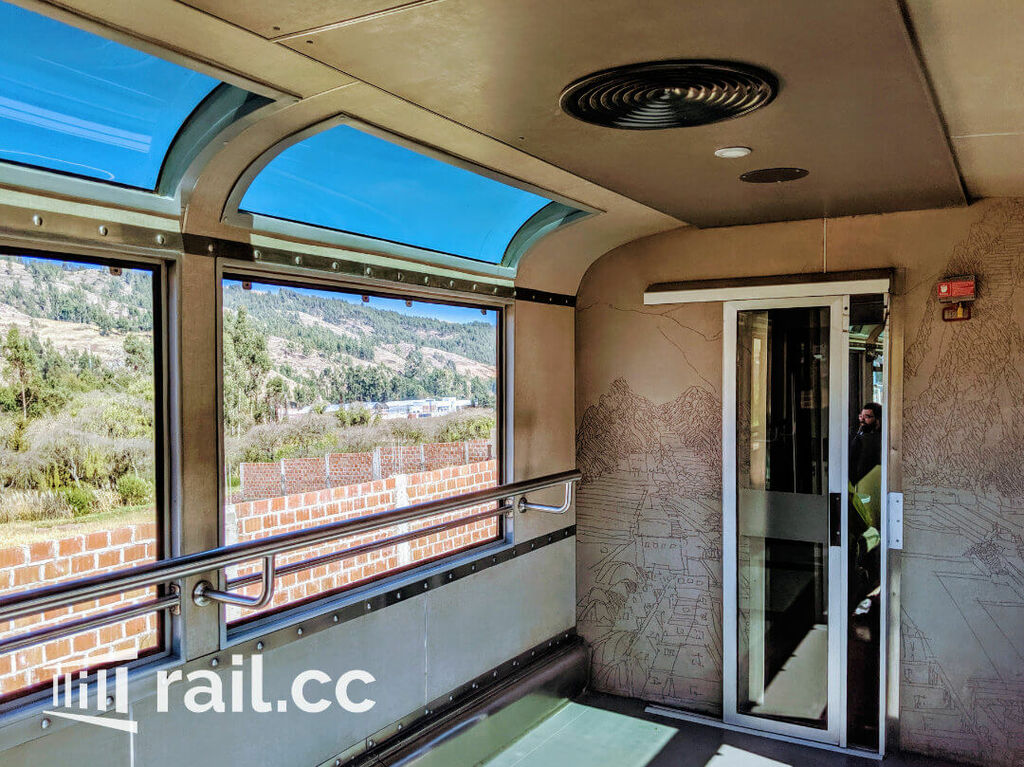
Open windows and handrails in the observatory waggon
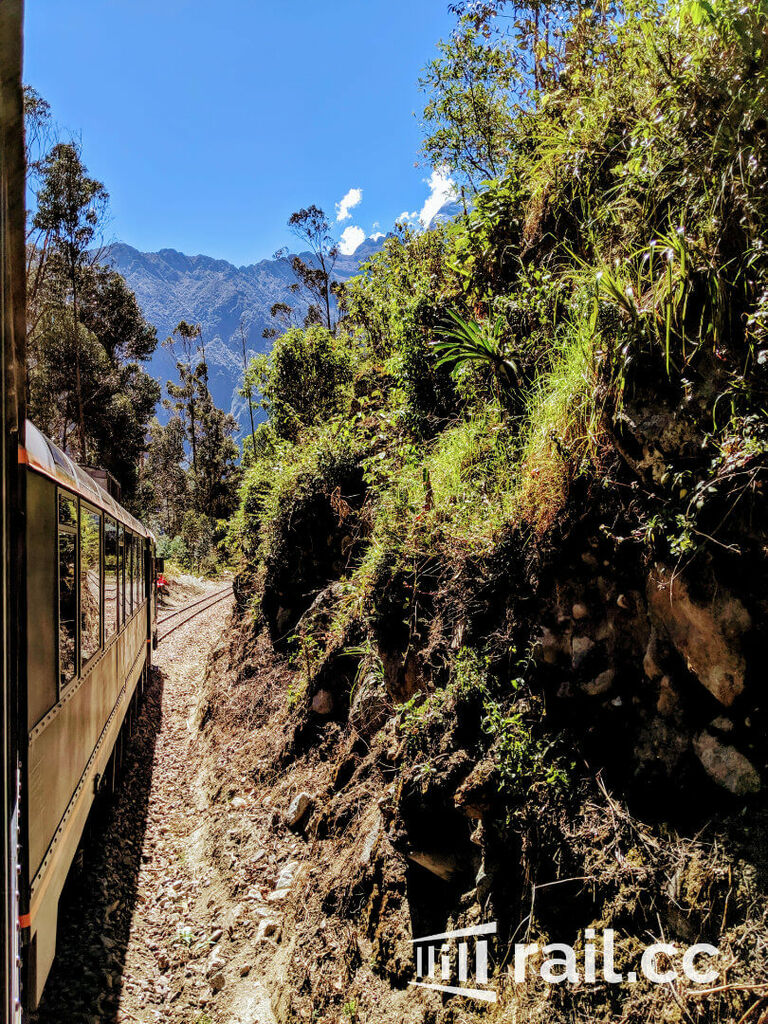
View from the observation waggon
The Craftbeer Bar
On the other side of the observatory wagon, I am surprised to find a Craftbeer bar. There, you have the choice between two different Craft beers (Chop & Chopp) from the Sacred Valley, as well as a traditional Peruvian cocktail (Chilcano) and a bag of crisps. Prices are pretty hefty for Perú ($6 for a 289 ml beer or 330 ml cocktail). You can get the “Native Potato Chips” for $1. In addition to that, this carriage offers a few bigger, more comfortable looking seats – but I couldn’t find out, how to book them.
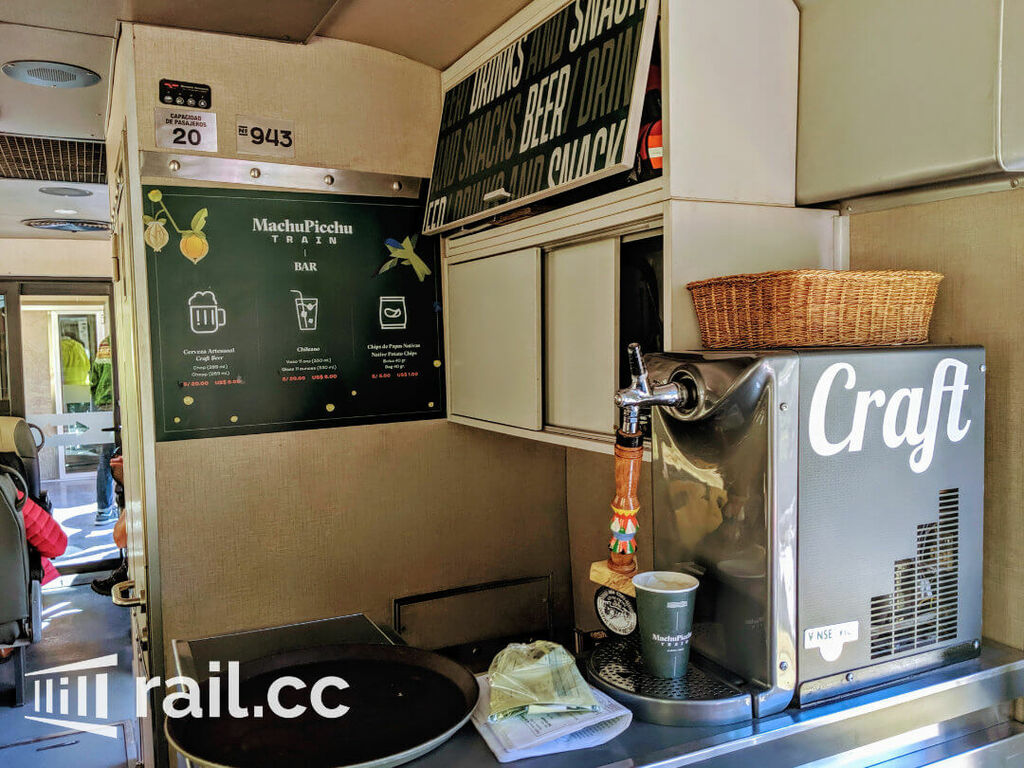
The Craft Beer Bar
In-Train-Entertainment
After having a look around, I got back to my seat to find a flyer about the advertised In-Train-Entertainment. It gives instructions, on how to log into the on-board Wi-Fi and how to access the different entertainment opportunities, which are the following: Books, movies, music, games, audiobooks, a railway map, an audio guide, and so on and so on … I am super excited, so I follow all the steps to log into the Wi-Fi in order to get started. Unfortunately, I get no further than to the welcome screen. A train attendant explains, that the network is probably overloaded and that there are usually interruptions during the journey. Hmmh. I can’t really do anything about that and feel a little disappointed. Nevertheless, a few of my fellow passengers were able to log in after all and send me screenshots of the in-train-app. Apparently, the audio guide – which I was particularly interested in – is built like a story, where two strangers meet on a train. That’s all I could find out about it. During the rest of the trip, I try a couple more times, but no luck. Bummer.
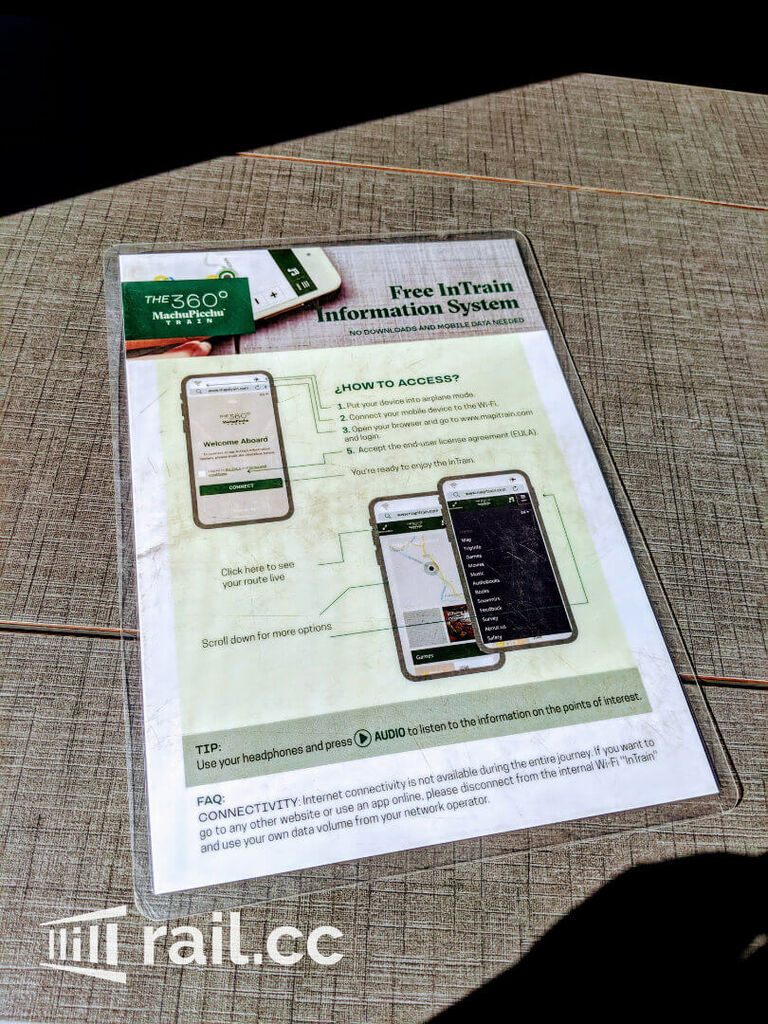
Information leaflet
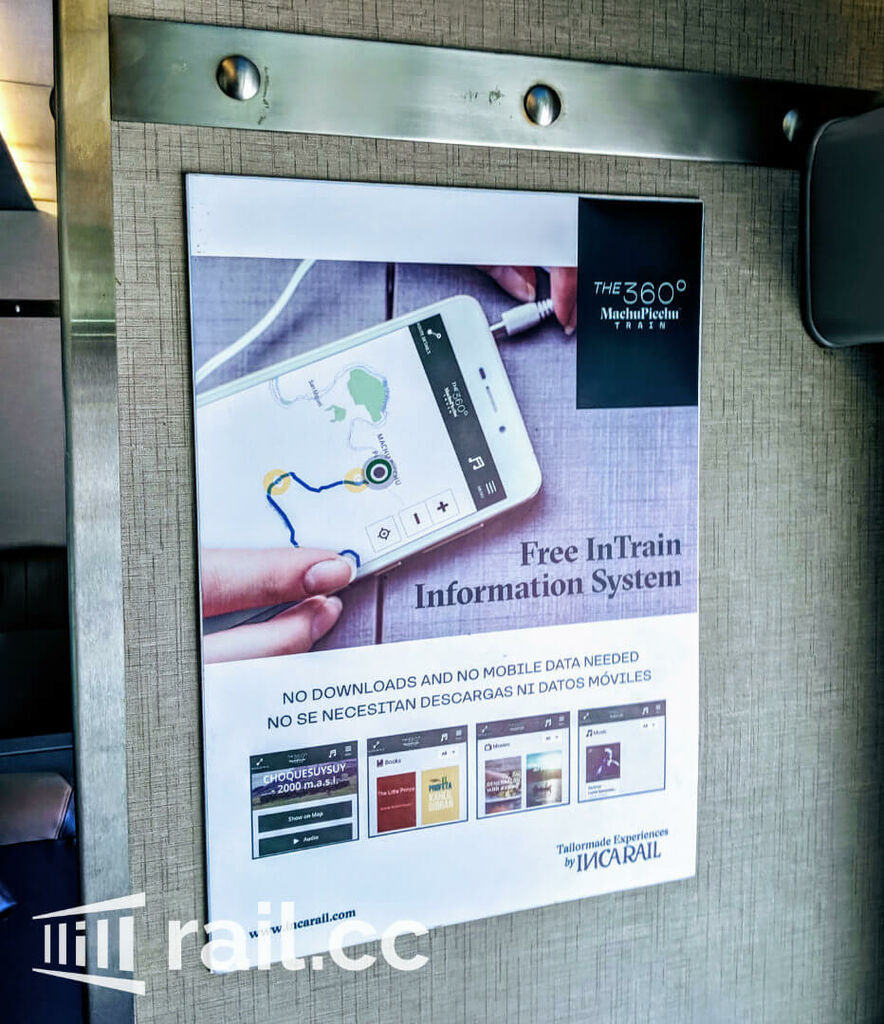
Poster in the train
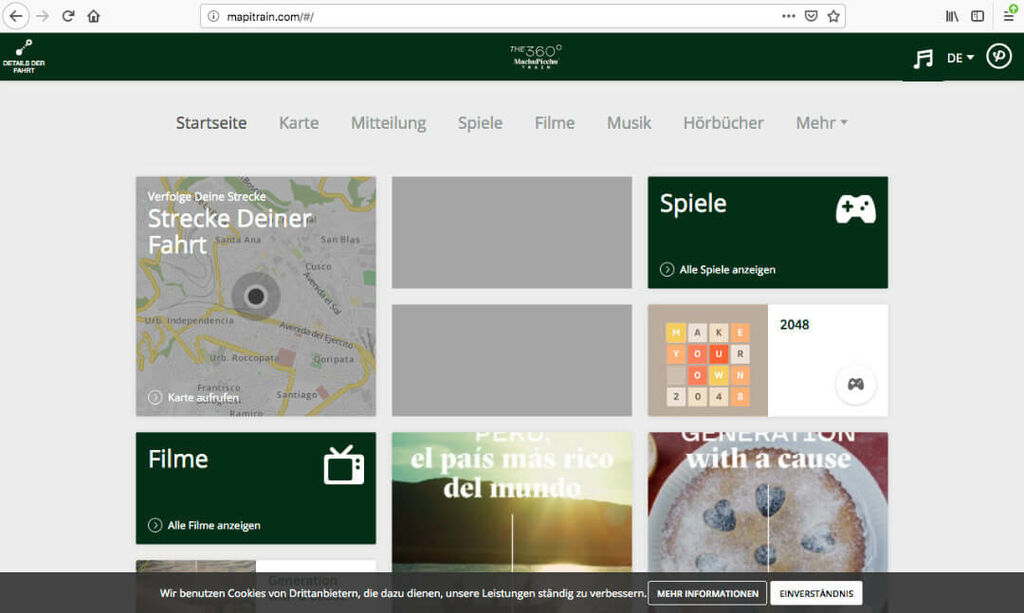
In-Train Entertainment homepage
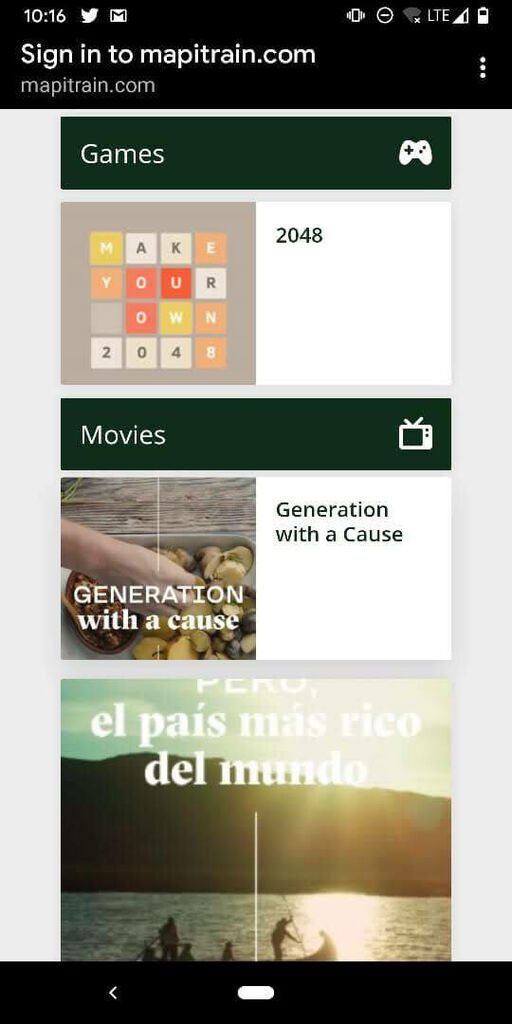
App-Screenshot 1
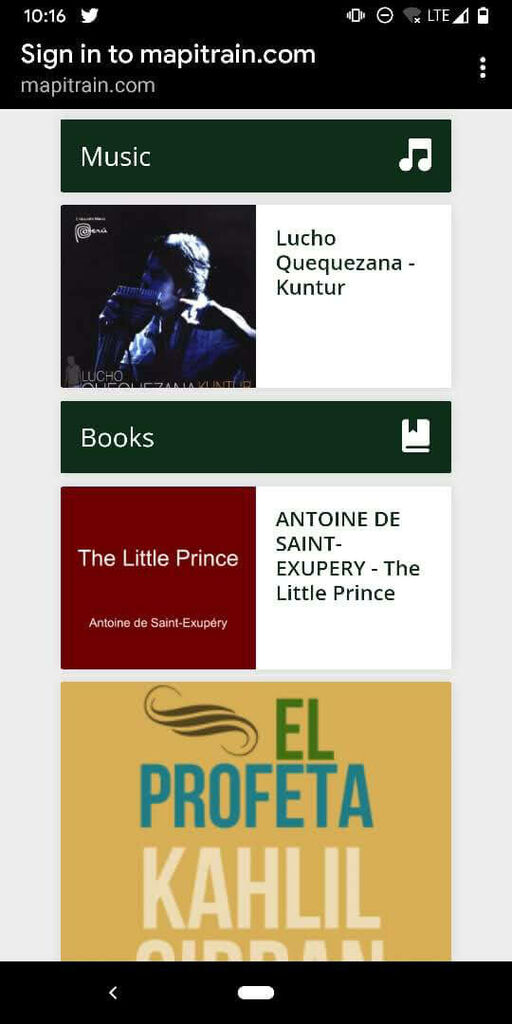
App-Screenshot 2

App-Screenshot 3
The journey
Cusco, San Pedro lies in the heart of town. Once we get rolling, thousand of small houses move past us and I get the chance to watch everyday life from my window seat. We snake through the steep streets, and to ensure a quicker climb, a method is used, that I already encountered in Ecuador, during my trip to the Devil’s Nose (if you’re interested, you can read all about it here): The switchback, where the train changes directions a couple of times, in order to climb an especially steep drop – or mountain – as fast and effective as possible.
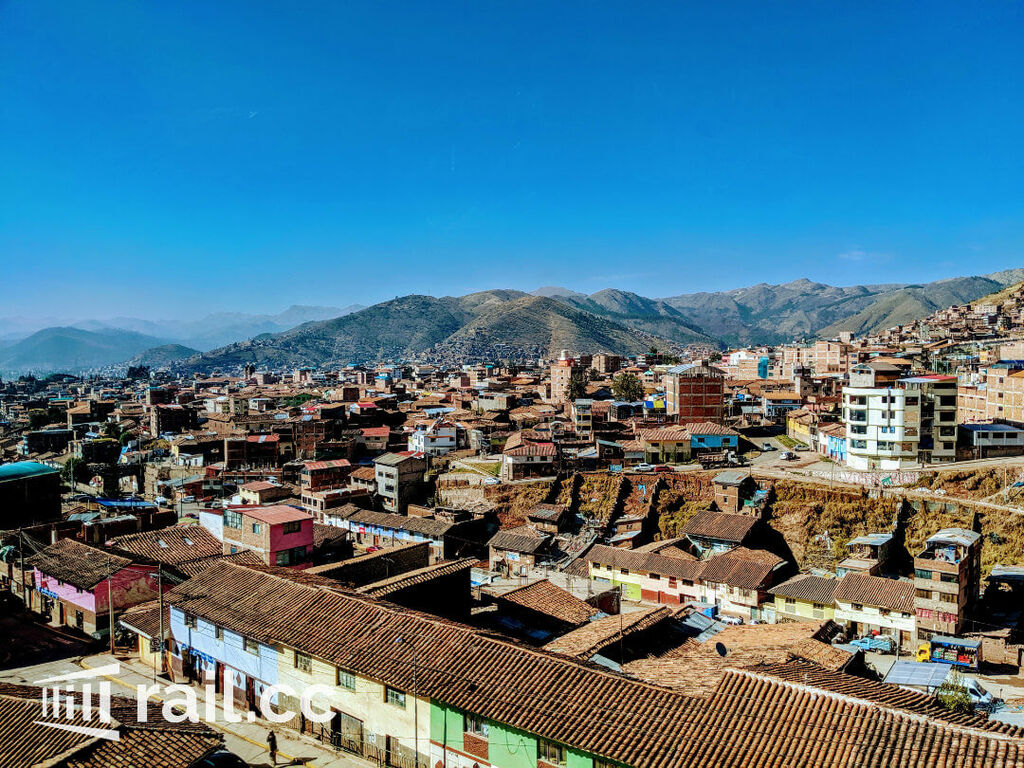
Views leaving Cusco
Soon, two neatly dressed train attendants come through the wagon and start their service, included in the ticket price, where they draw your attention to the observatory wagon once again. Firstly, you get the choice between coffee and ice tea. Since it’s still early in the morning, I opt for my beloved black gold – no sugar, no milk – and along with that, I am also handed a pack of traditional cookies (Bastoncitos de Kyon). During my time as a traveller, I have had friendlier train attendants, but maybe the grumpy-ish lady simply had a bad day. After all, the coffee was hot and tasted quite pleasant, even if it was made with slightly tasteless coffee sirup, as almost all Peruvians do it. Yet, the cookies were amazing and instantly let to a nice chat with the girl sitting opposite to me. After this more than welcome snack, I went to the observation wagon to soak in the landscape and take some pictures.
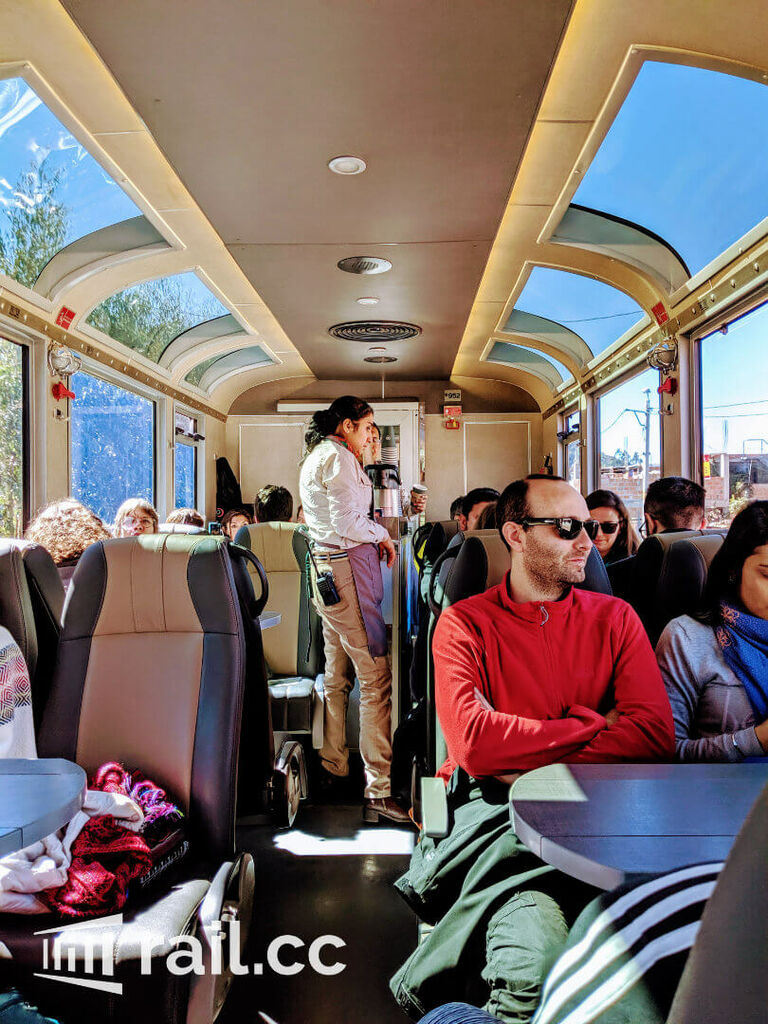
Service on the train
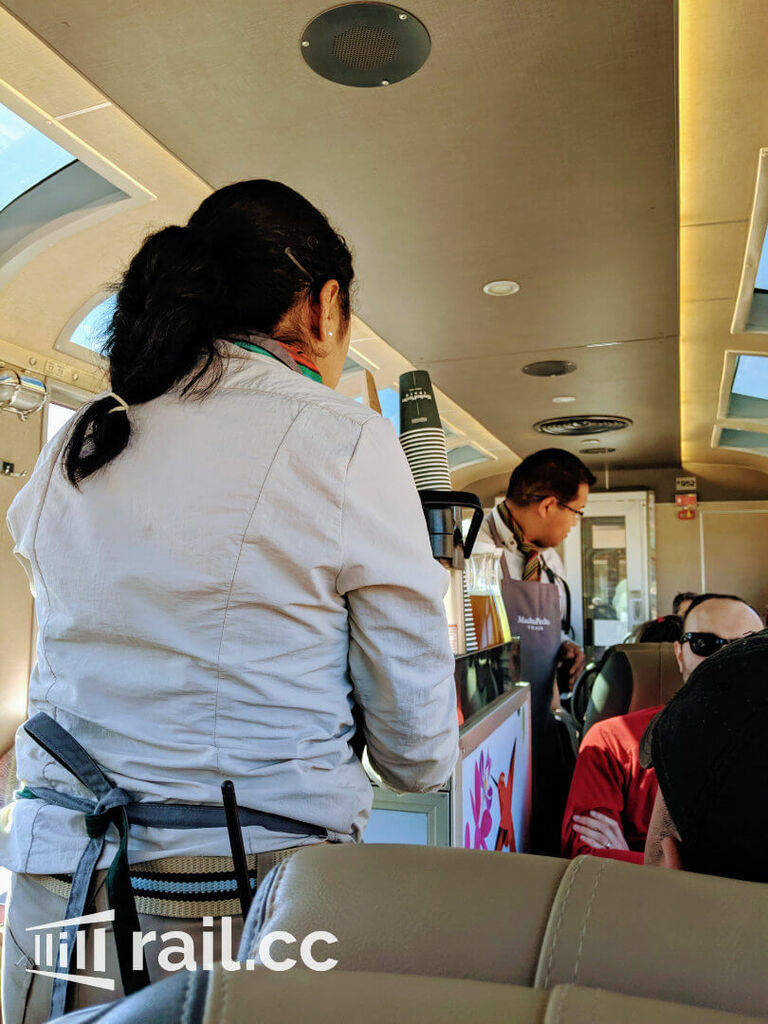
Push-cart with drinks and snacks

Coffee and Cookies
Our first scheduled stop is in Poroy, where a few passengers enter and exit.
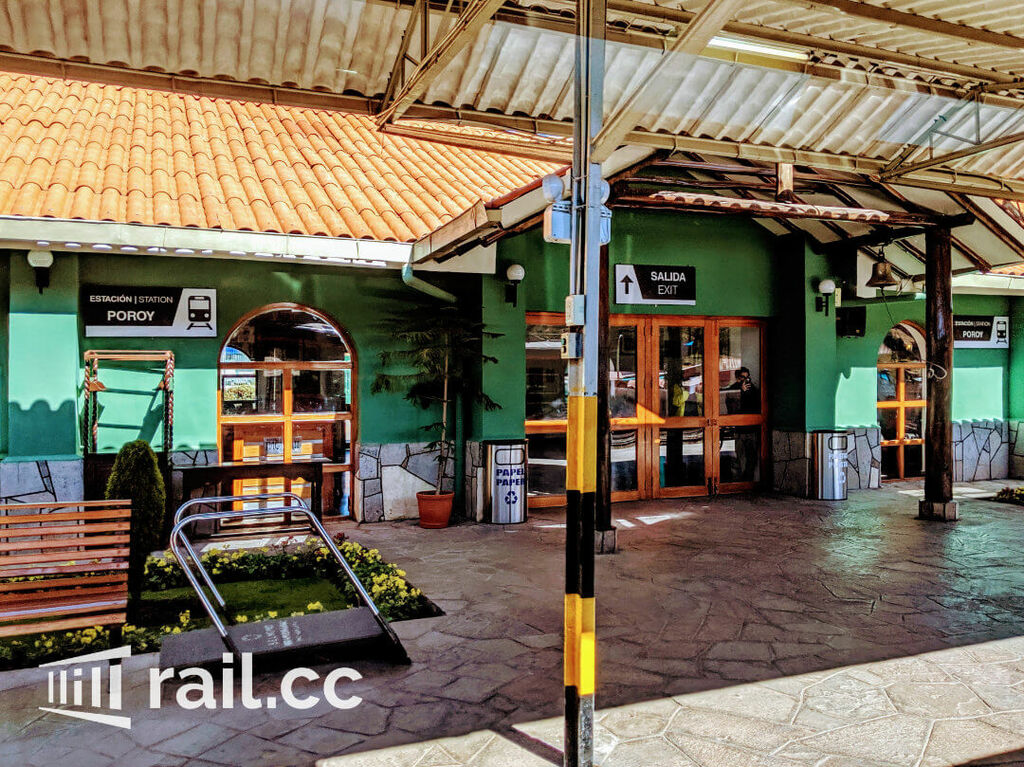
Poroy station
Soon, we head on and snake through the Andes, along rivers, small villages, abandoned huts – always with the snow capped mountains watching over us. Truly a ride to enjoy, I can’t get enough of it! Half of our journey is already over when we arrive in Ollantaytambo (after stopping at several occasions to wait for oncoming trains).
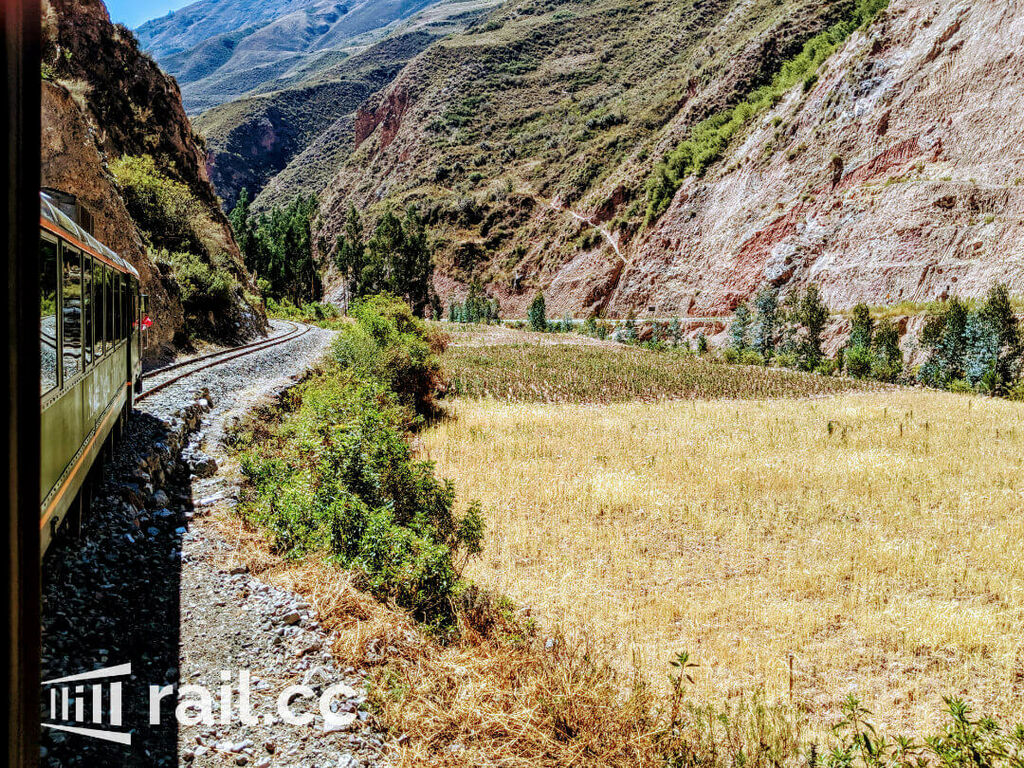
View from the train
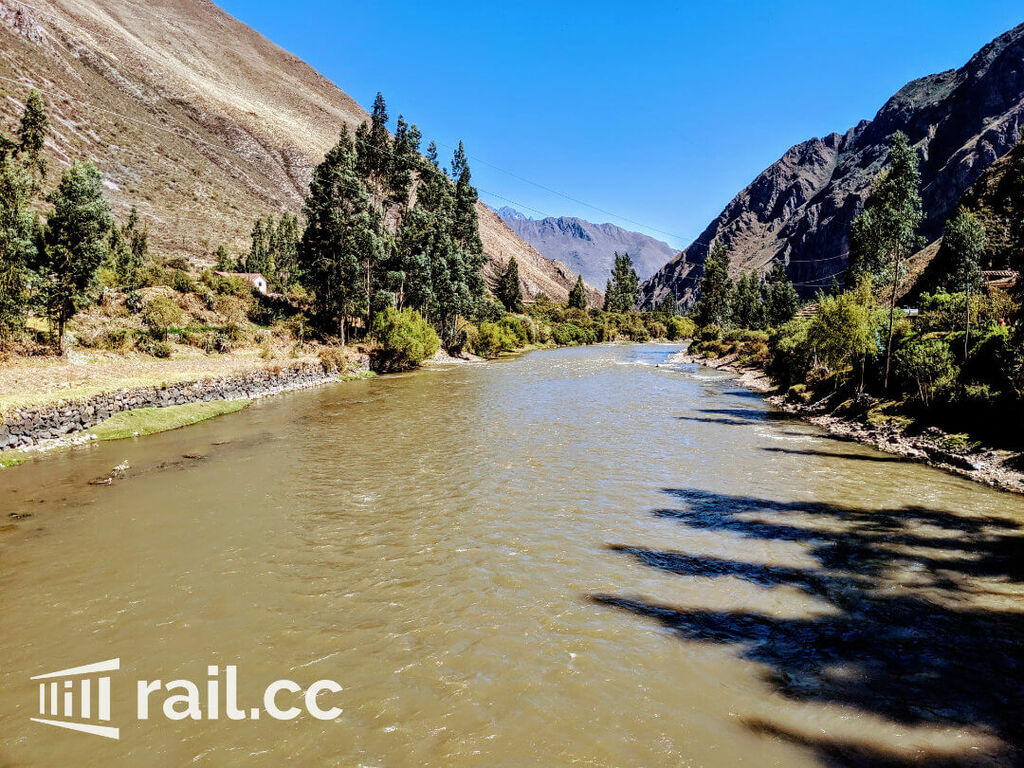
Over the river in the observatory waggon
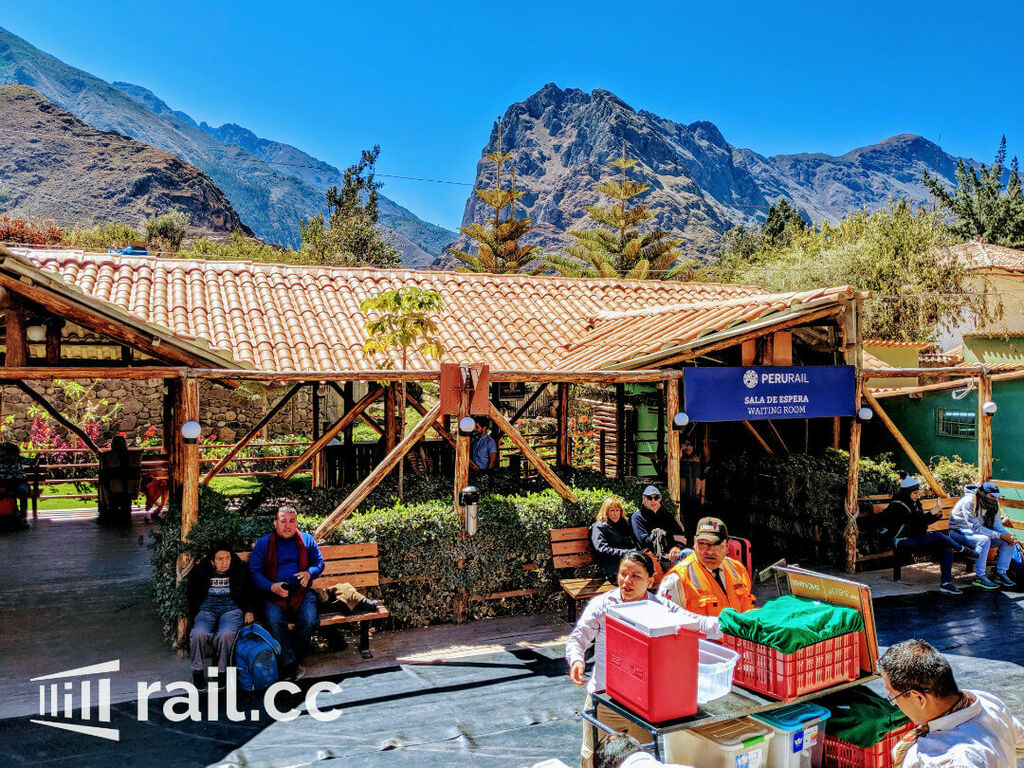
Ollantaytambo station
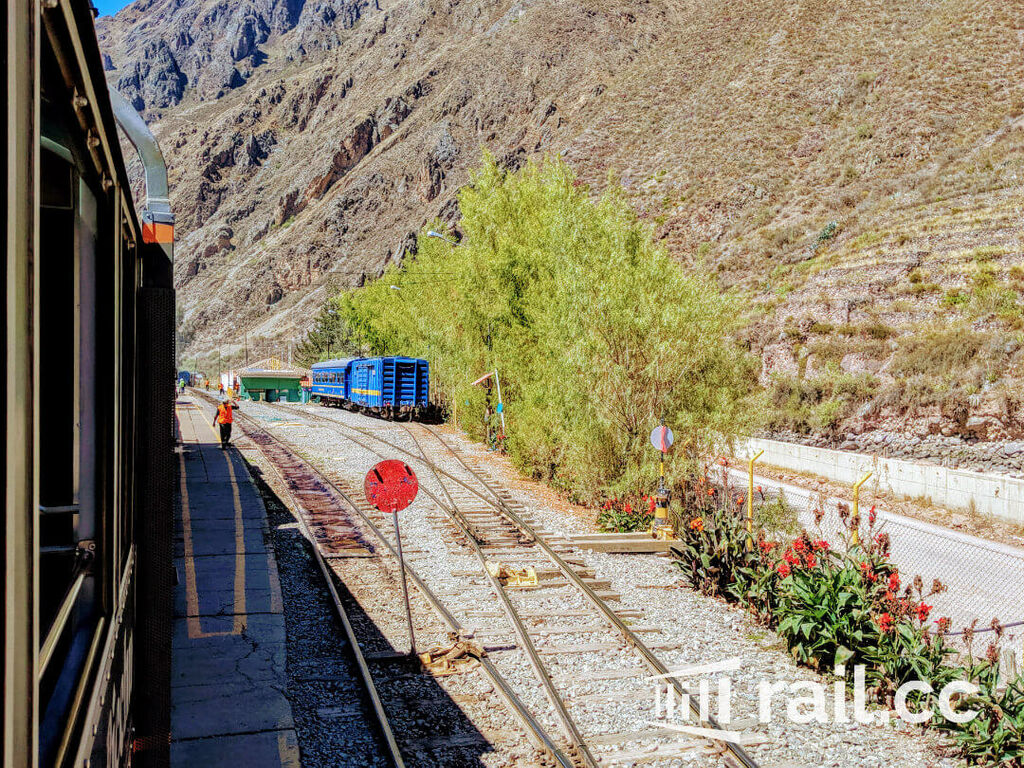
Waiting in Ollantaytambo
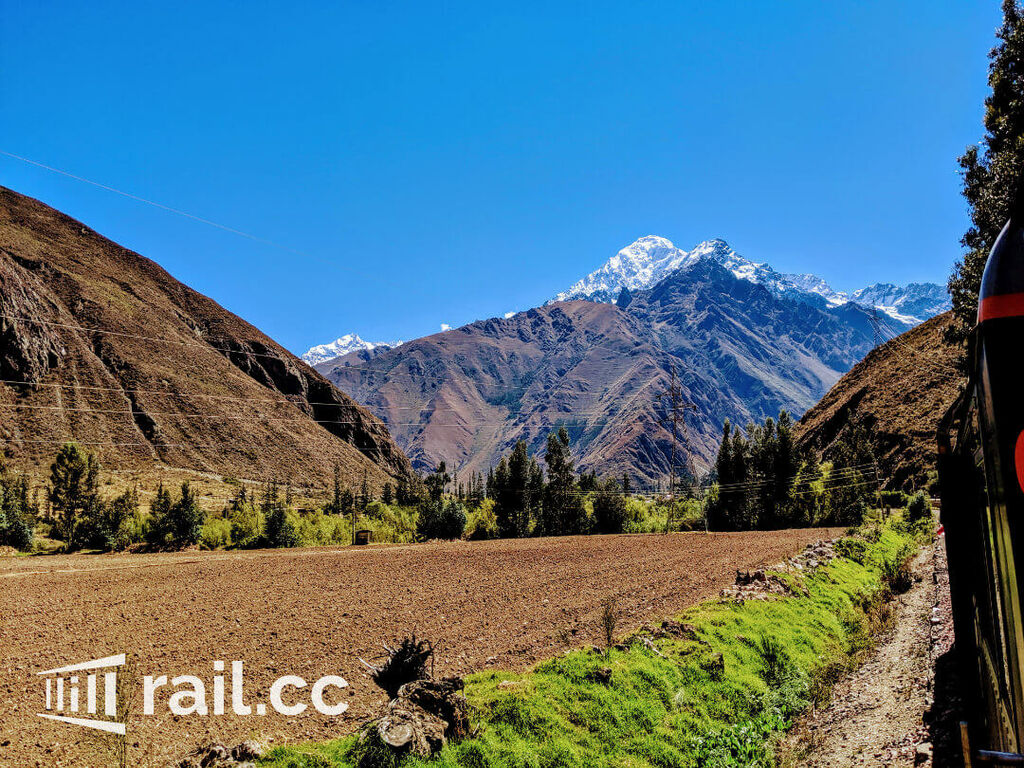
Amazing mountain views
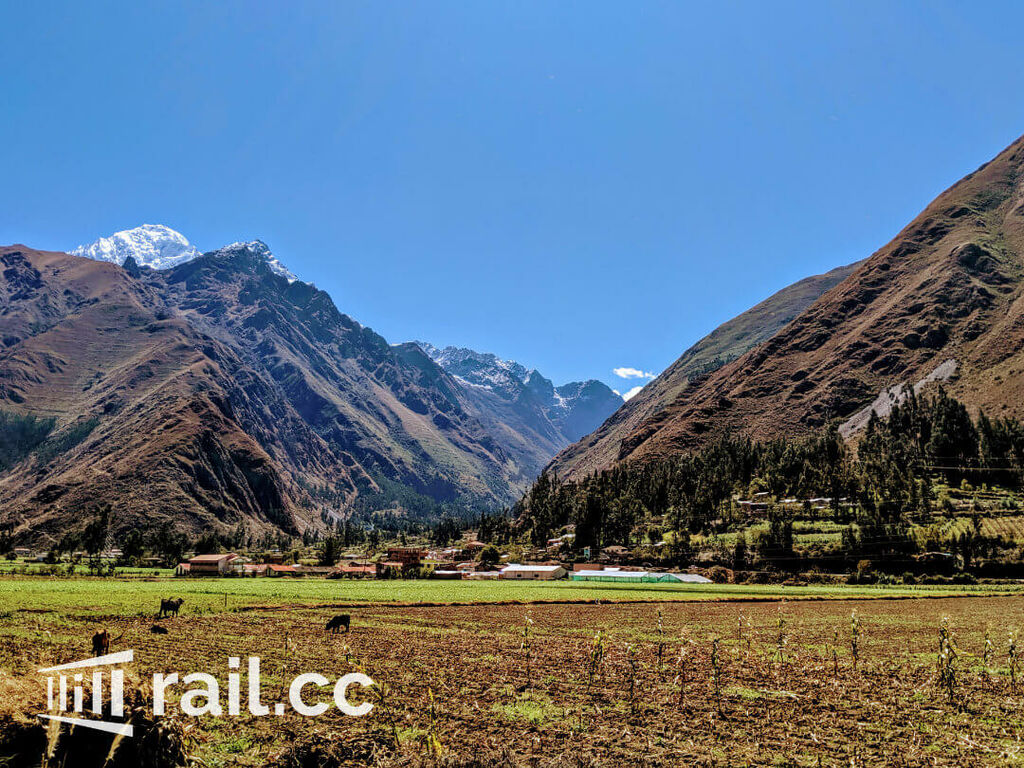
I can’t get enough of those mountains
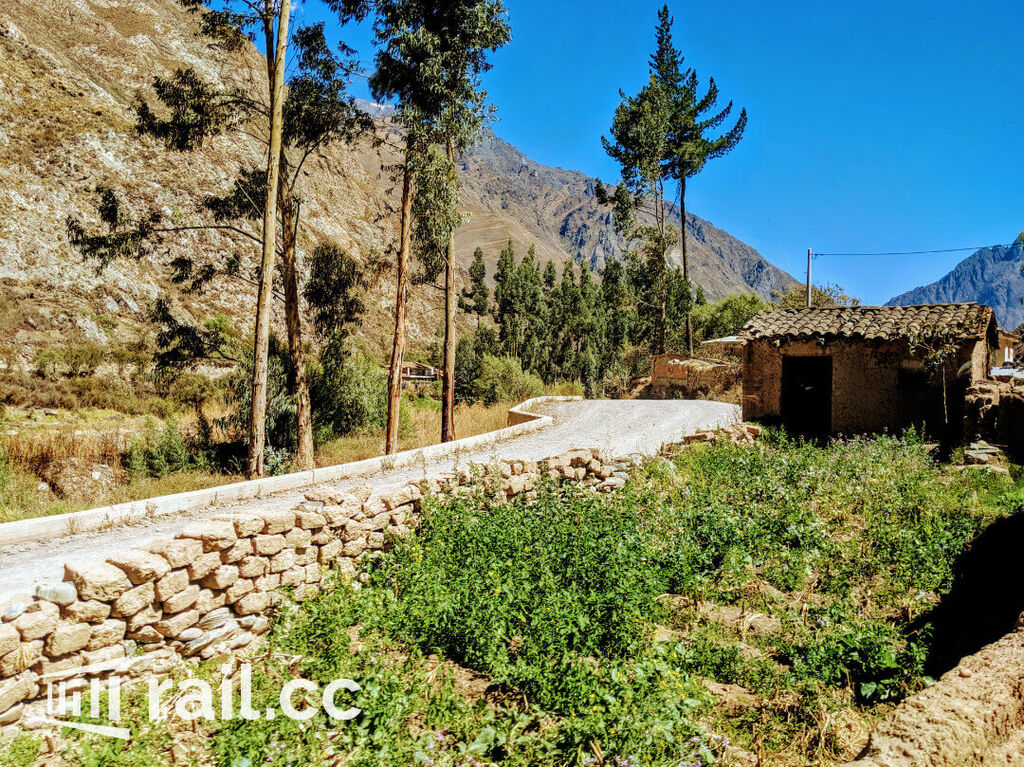
Villages passing by
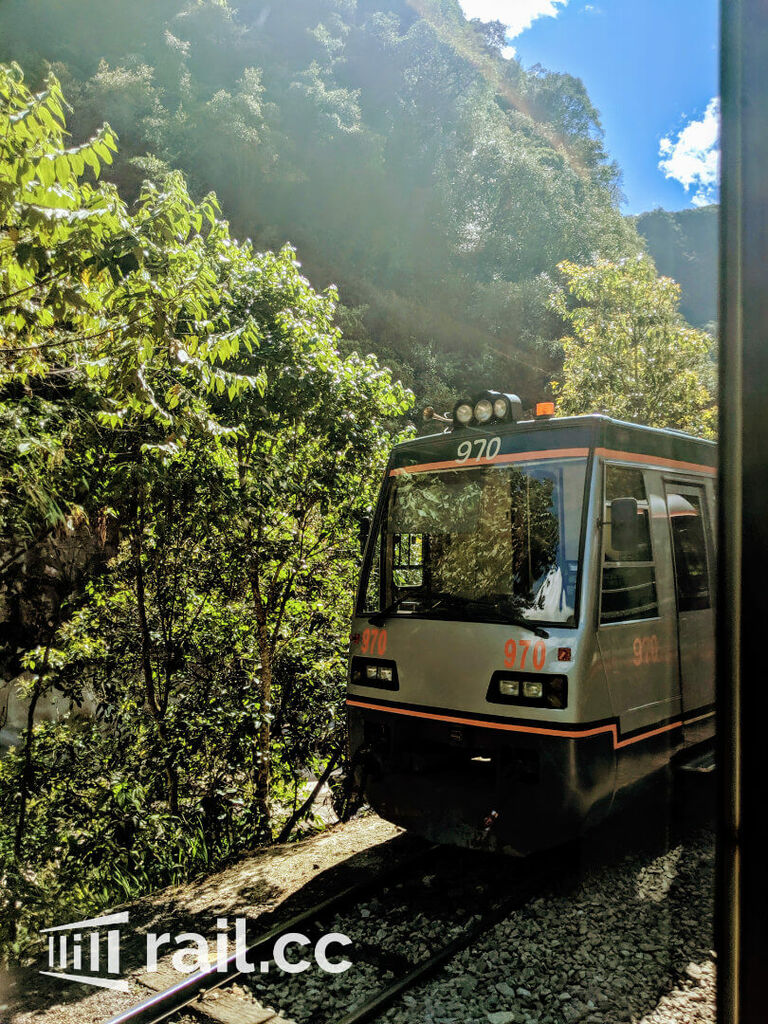
“The Voyager” passing by
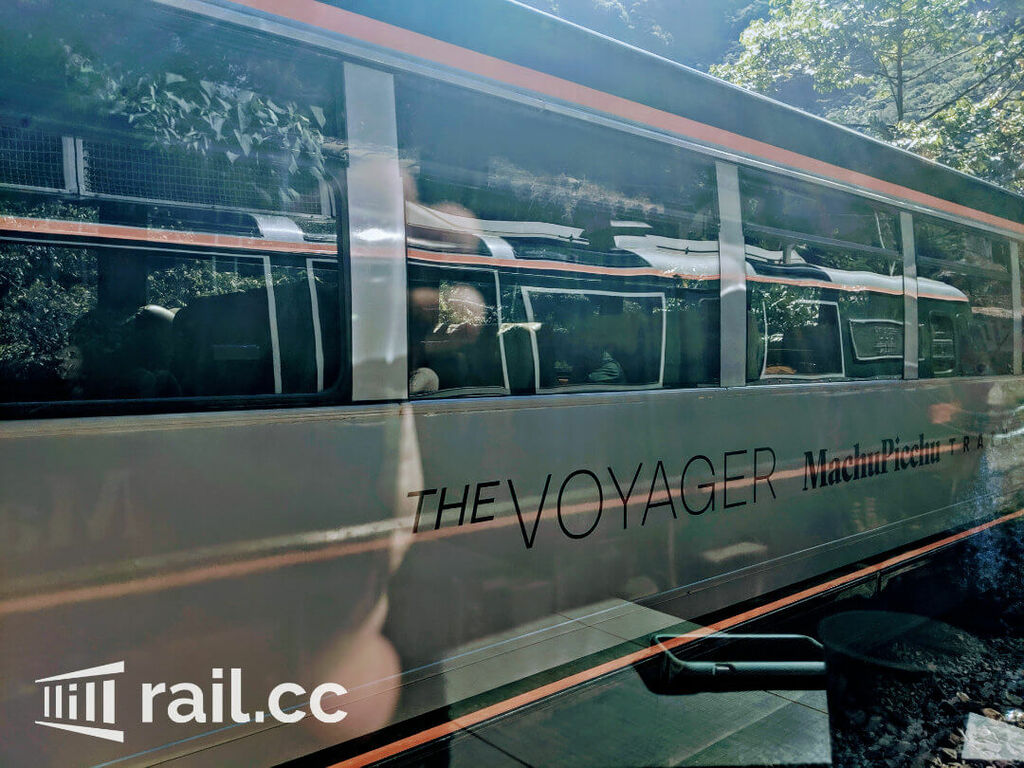
A quick look at PeruRails Voyager
There, more passengers – and more food – enter the train. It’s time for the advertised box-lunch, which comes in shape of a fairly dry chicken wrap (vegetarians can pre-register and receive something else accordingly), a mandarine, a tiny chocolate bar and a muesli bar. Again, you get the choice between coffee and ice tea (Té helado). This time, I decide to get a pineapple ice tea, which turns out to be surprisingly tasty (even, if a little sweet). You definitely won’t have to starve on this train! Later on, the Craft beer and snack menu is being handed out; this time, I pass. Looking out the window, the landscapes begin to change…
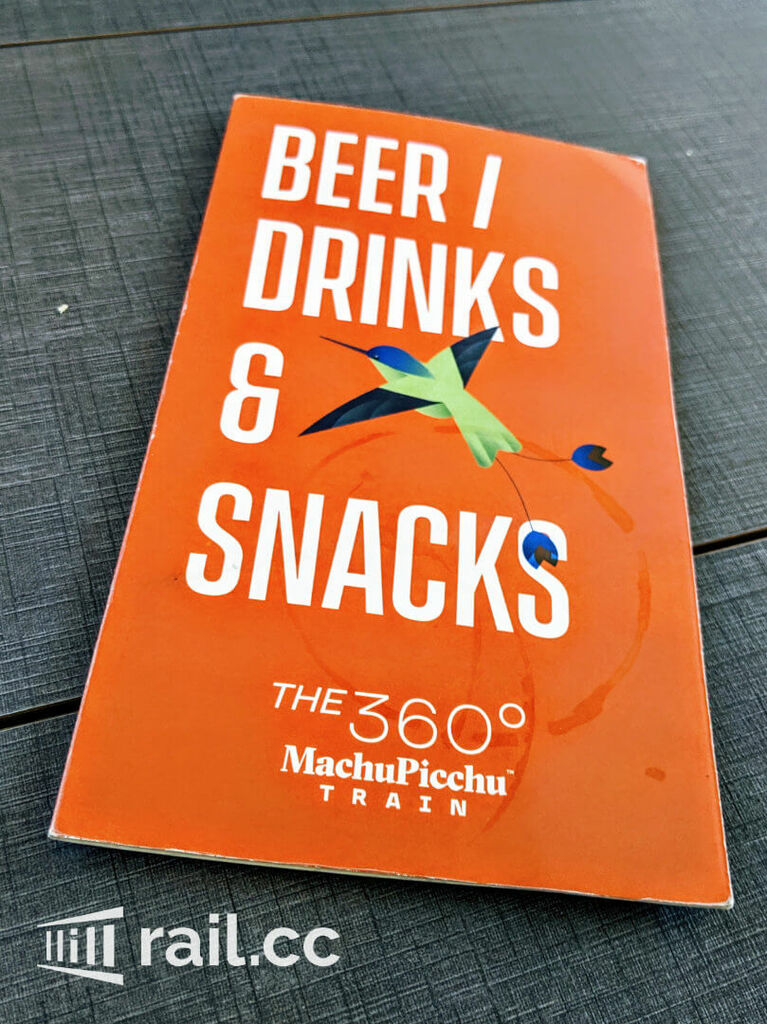
Craft Beer and Snack menu
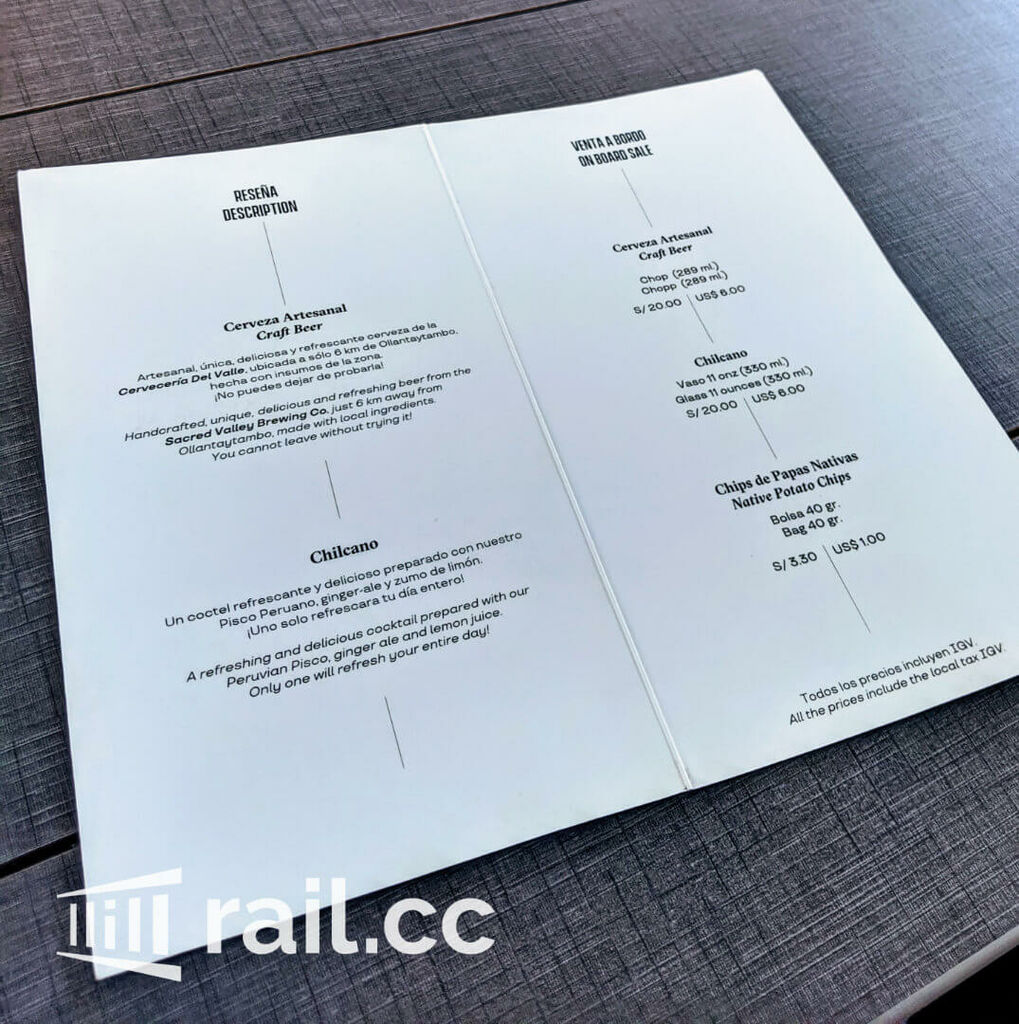
Beer a la carte
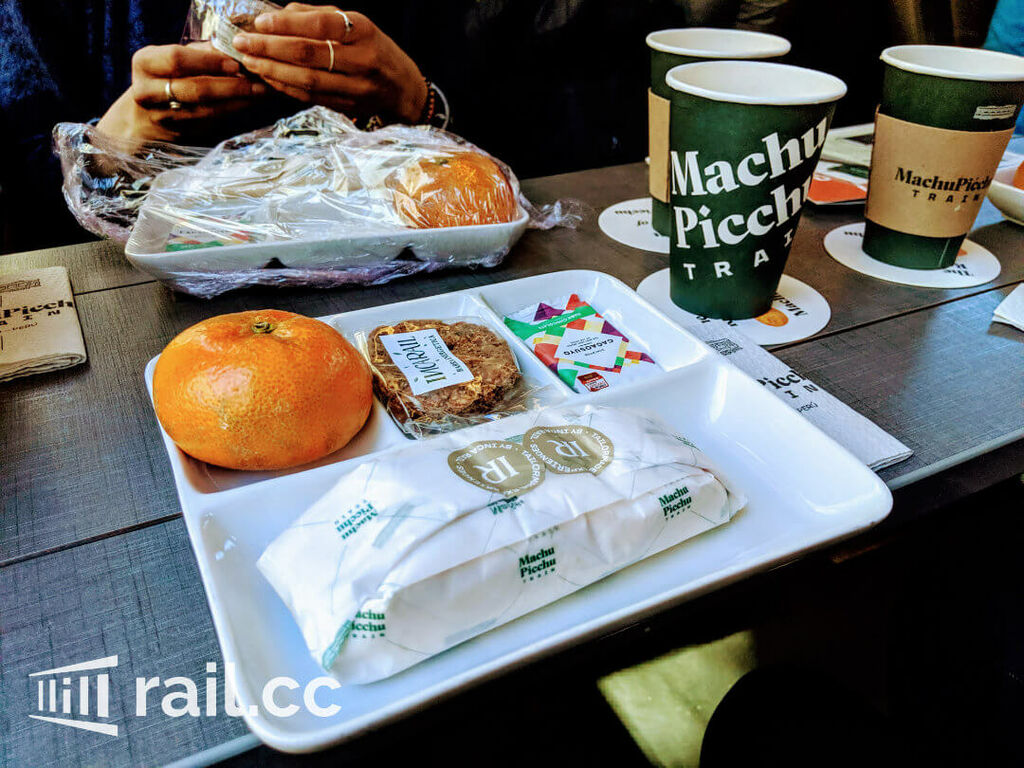
Lunchtime
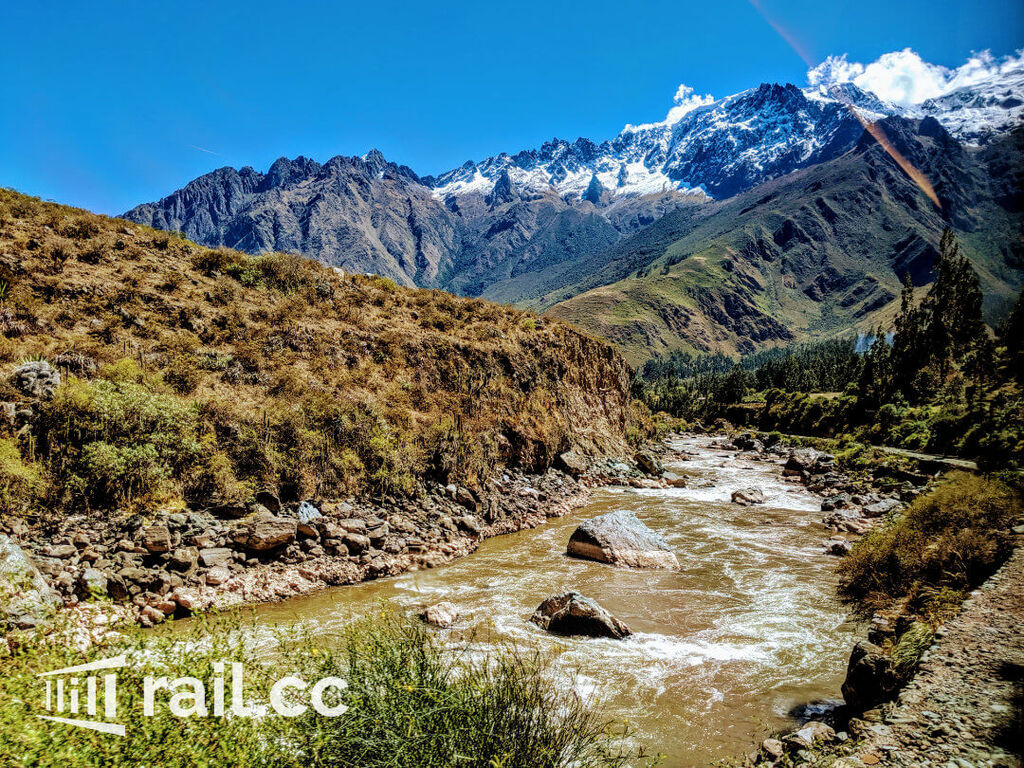
More incredible mountainscapes
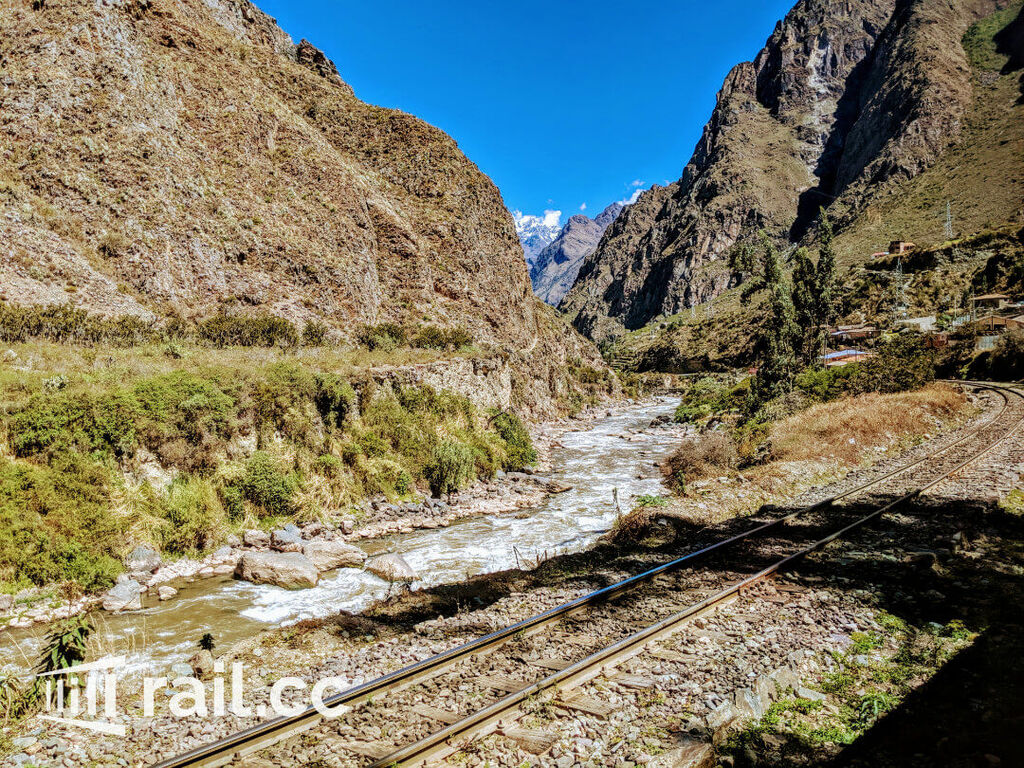
We’re getting lower
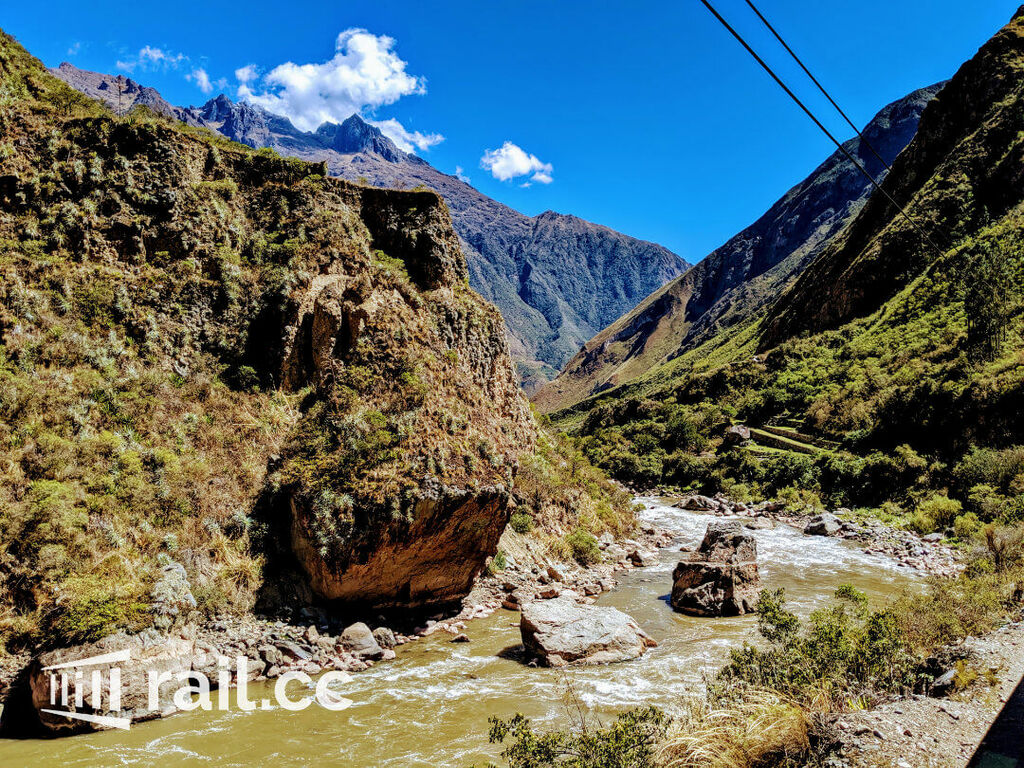
Along the river
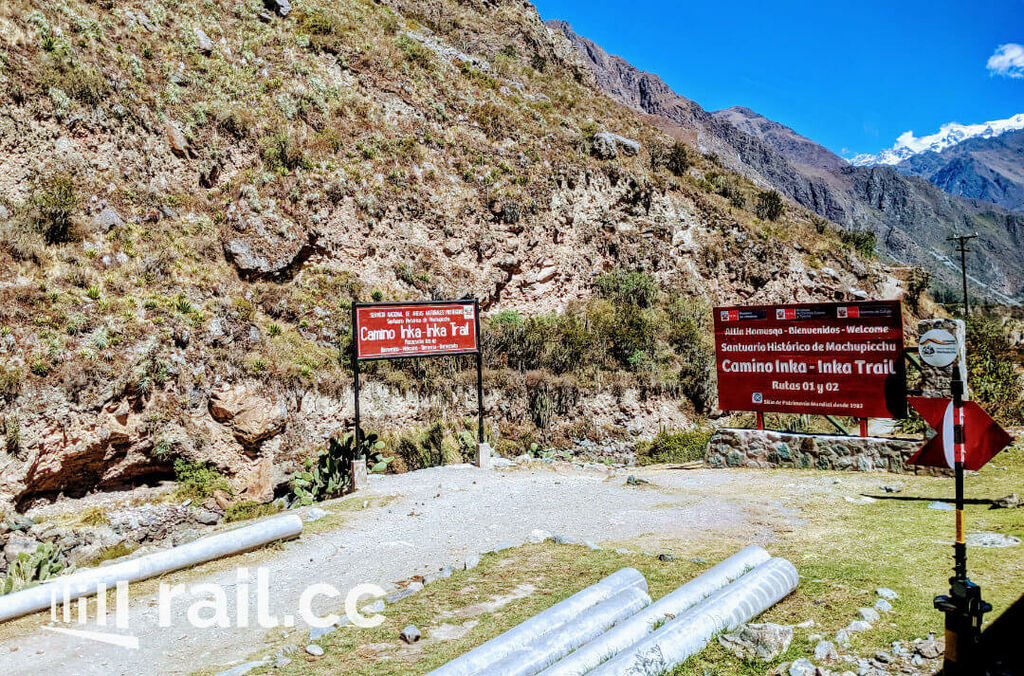
Passing the InkaTrail
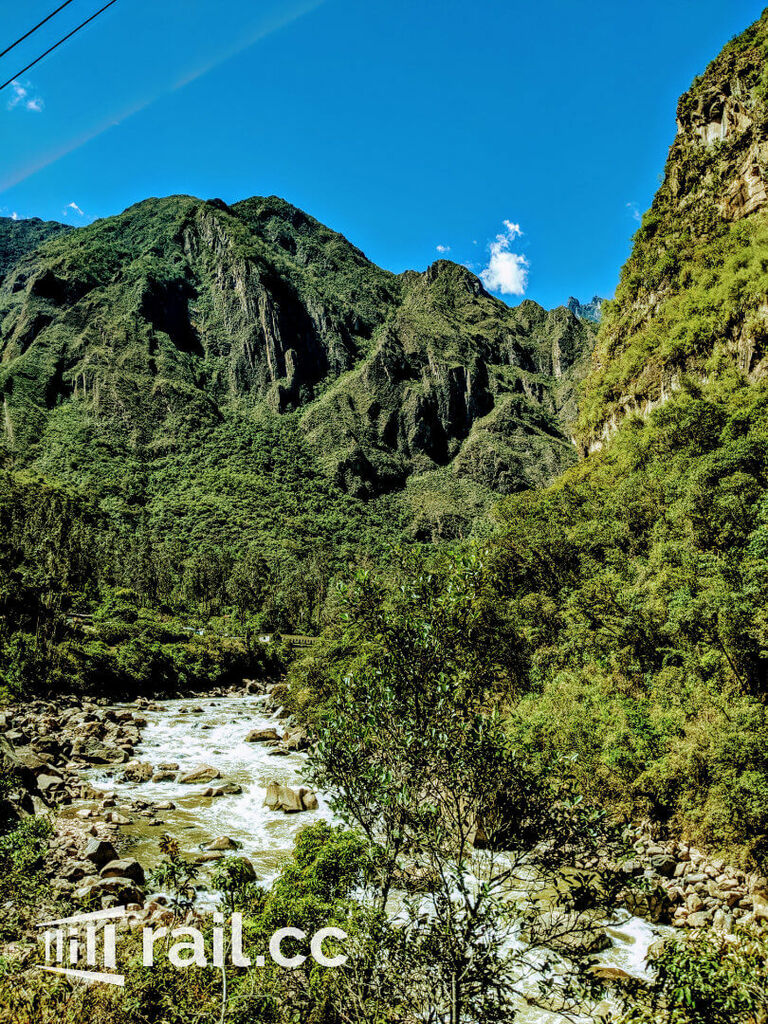
Lush mountains
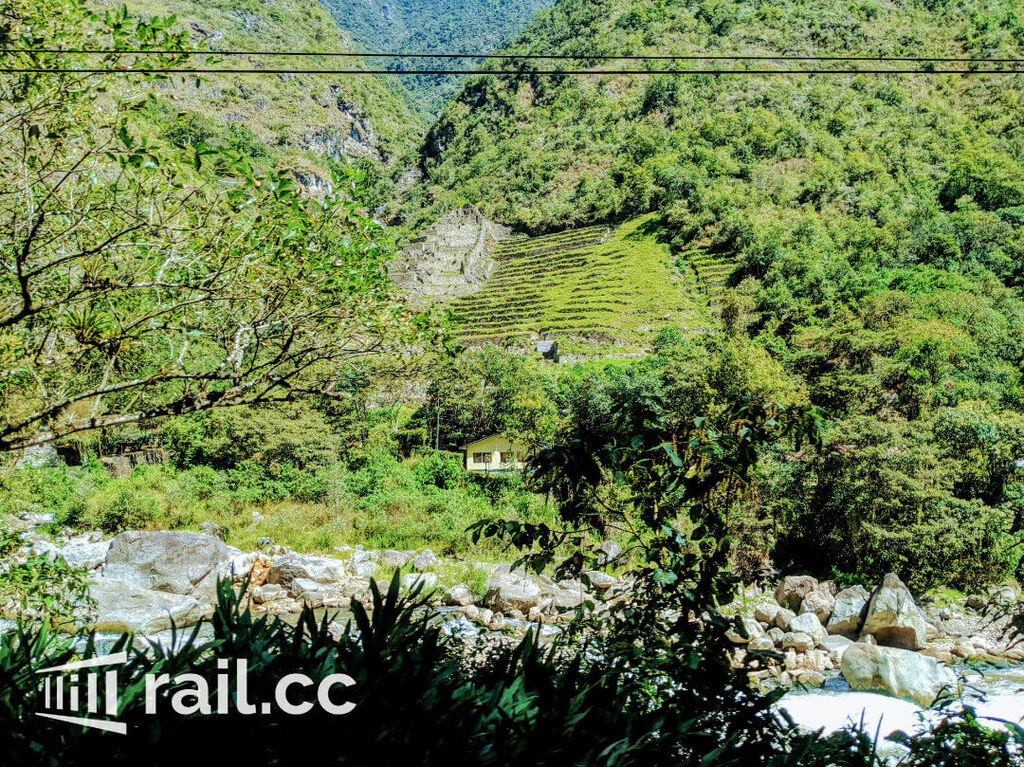
The first small ruins!
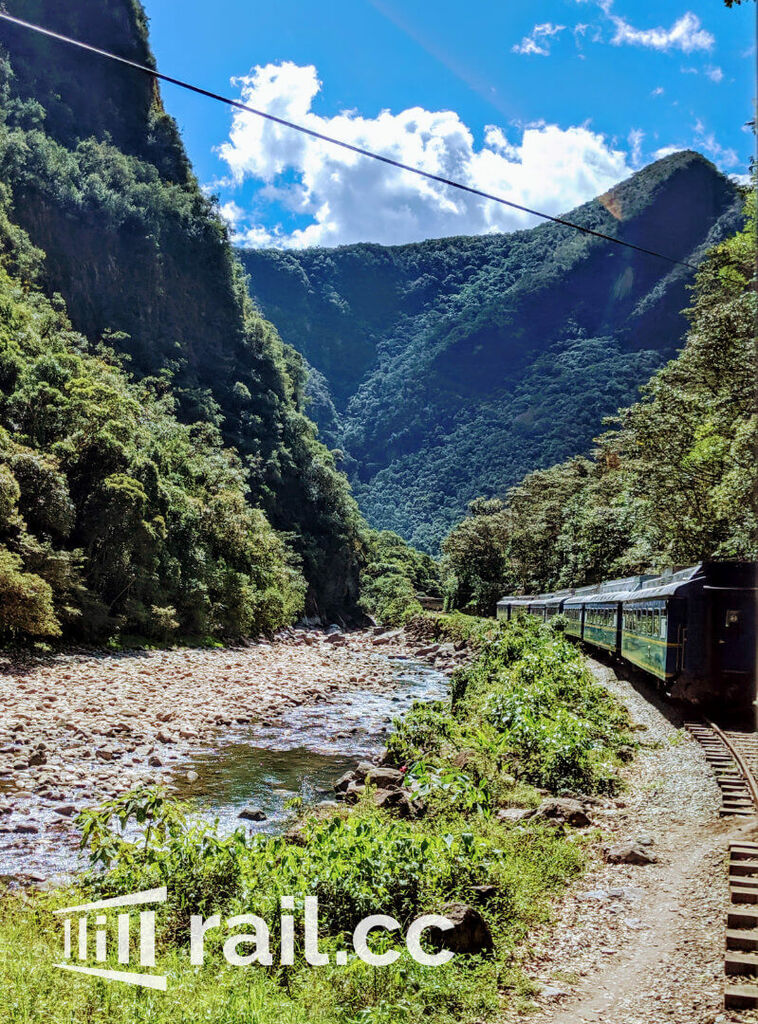
Sacred Valley views
Arrival in Aguas Calientes
We’ve already lost a couple of hundred meters in altitude and it gets warmer and greener outside. Our journey continues along the river through a rainforest, until an announcement tells us, that we will be arriving soon. Everybody’s starting to get ready, the first houses can already be seen and the train comes to a stop at the village entrance.
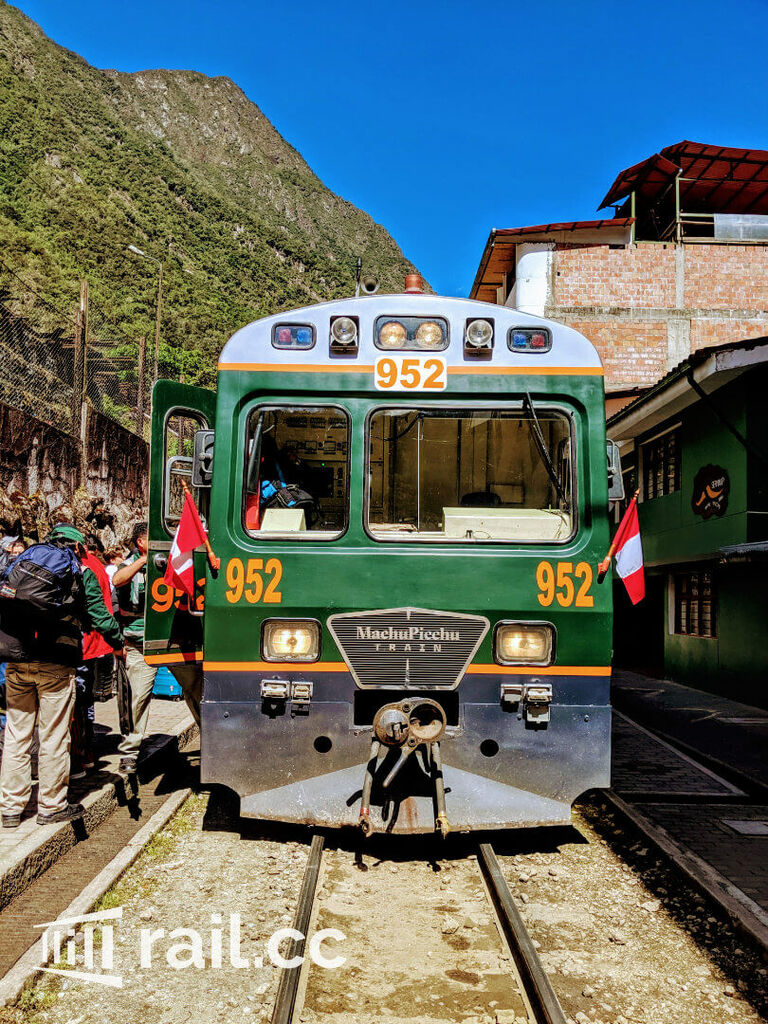
Arrival in Aguas Calientes
Technically, it’s not a “train station”, but I follow the crowds to get out. The sun’s shining, it’s warm, you can hear the river splatter and after 4.5 hours, that simply flew by, my train adventure has come to an end.
As it turns out, Aguas Calientes has multiple “train stations”, whereas only one has a real station building and is located near the artisanal market. There, you can find a waiting hall, cafés and bathrooms. The second station is only being used for the local and cargo trains, operated by PeruRail. But no matter which company you’re going with, you should double-check your departure station and, if necessary, ask at one of the offices (IncaRail or PeruRail), to make sure, you’ll wait at the correct one. Since I didn’t go back by train, I can’t tell you anything more specific.
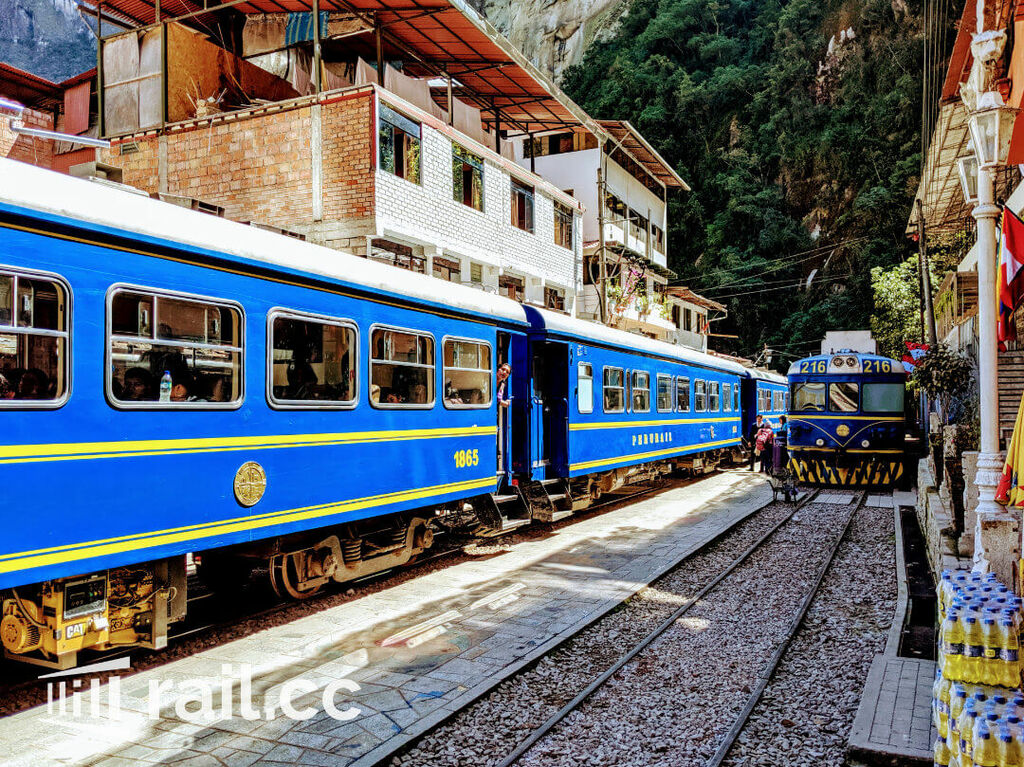
PeruRail Station for the local train and cargo trains
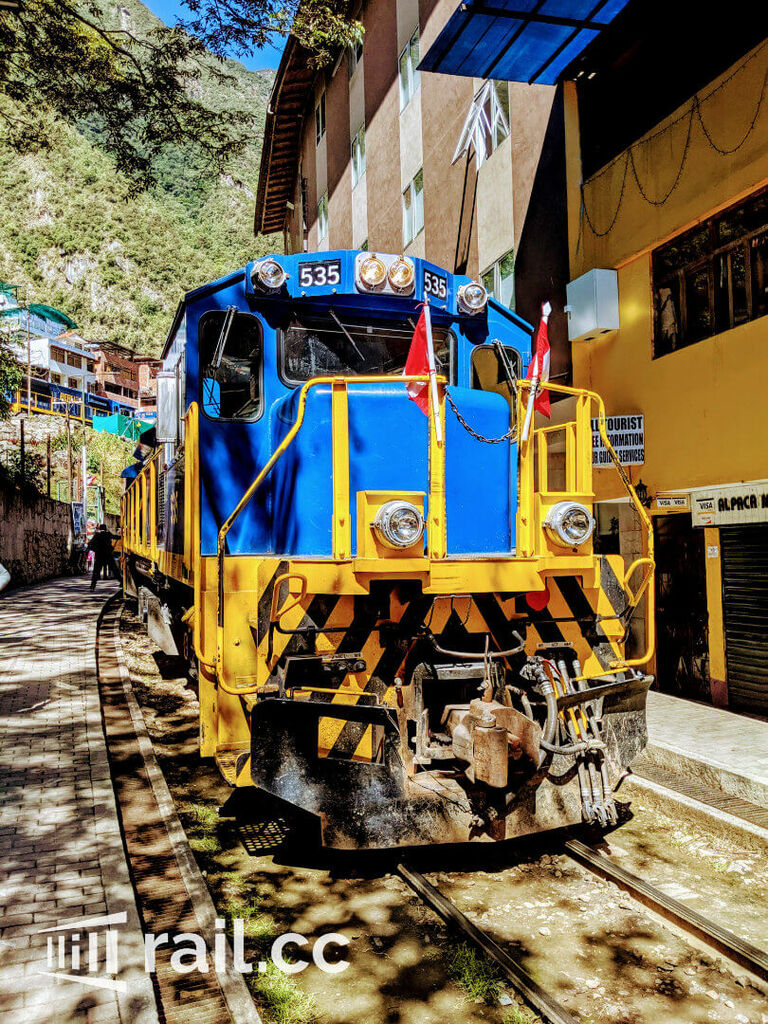
Cargo train waiting at the station
Aguas Calientes
Aguas Calientes (span.: “Hot Springs”) is a neat little town, which – apart from Machu Picchu as its main attraction – also has to offer some thermal springs. It is surrounded by lush forests, covering the mountains of Sacred Valley, at the foot of the old Inca capital, and the view – even seen from below – is absolutely spectacular. Of course, the place is very touristy, and so are the prices. Nevertheless, I really enjoyed my time here. If you’re up for really tasty Italian food, as well as great service for okay prices, I would like to recommend the “Incontri del Pueblo Viejo” to you (the Tiramisu is an experience!).
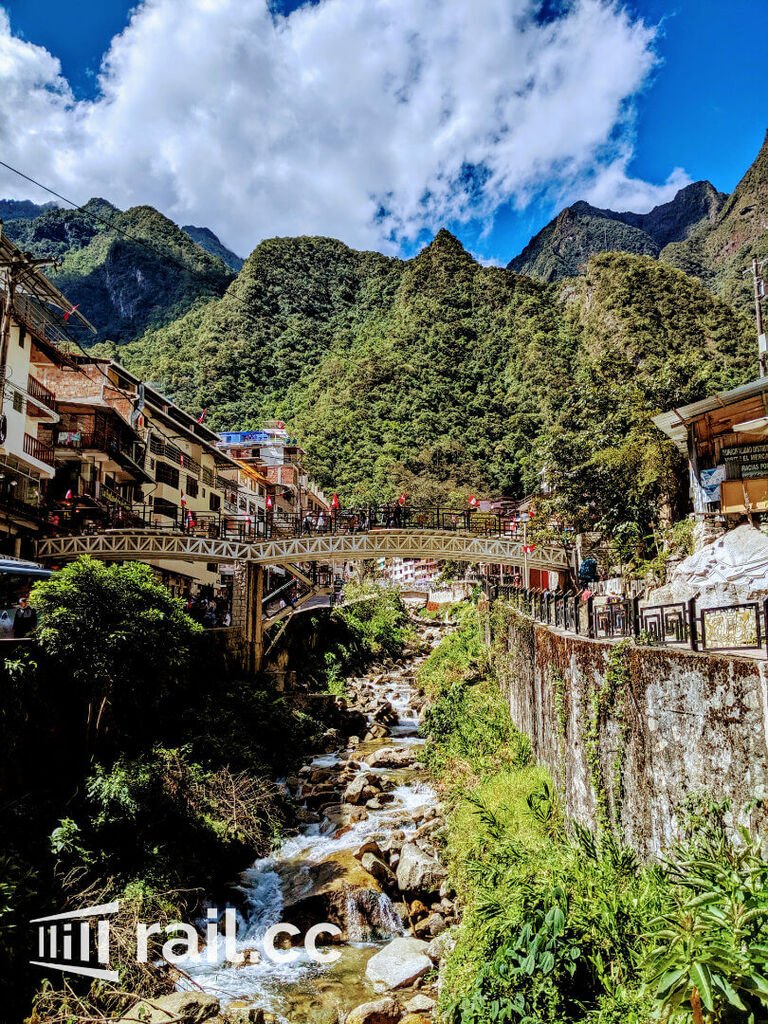
Aguas Calientes
There is a huge choice of hotels and also a few hostels. Because of my quite spontaneous booking, most of the places were already booked. I found shelter at the Perutambo. An inexpensive hotel/hostel with friendly staff and clean rooms. You will have to bring some earplugs, though, because the hotel is located right next to a popular sports ground, where it can be quite loud until late at night. Yet, I did enjoy my stay there, which had good value for money (€30 per night for two people).
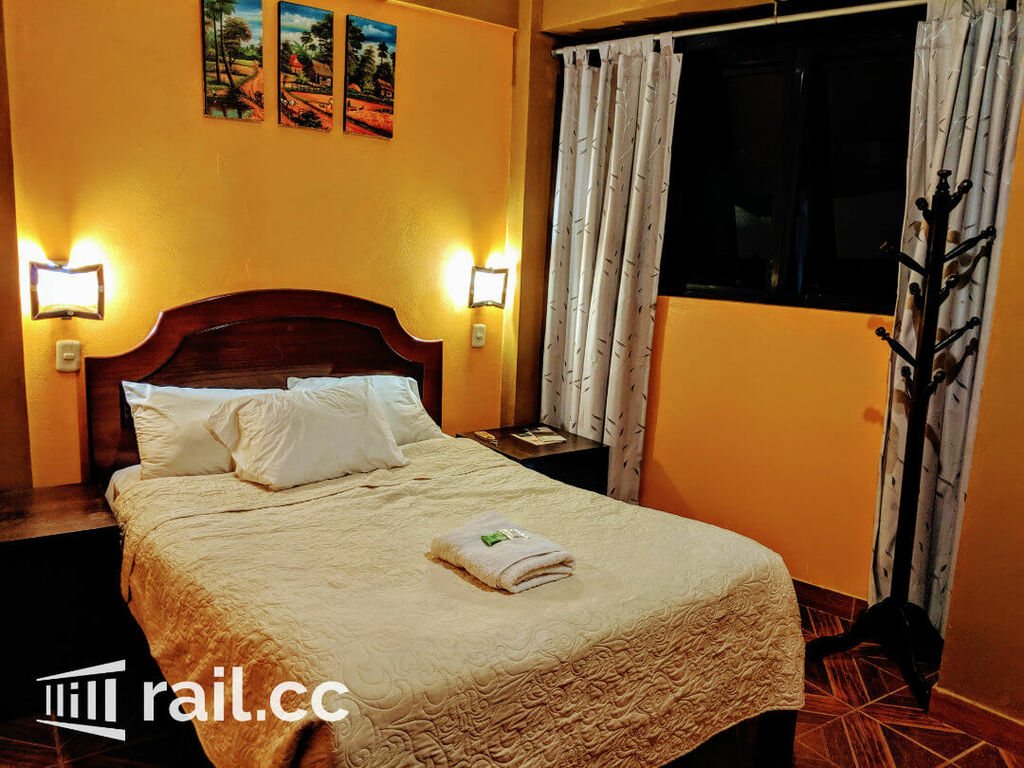
My bed for the night
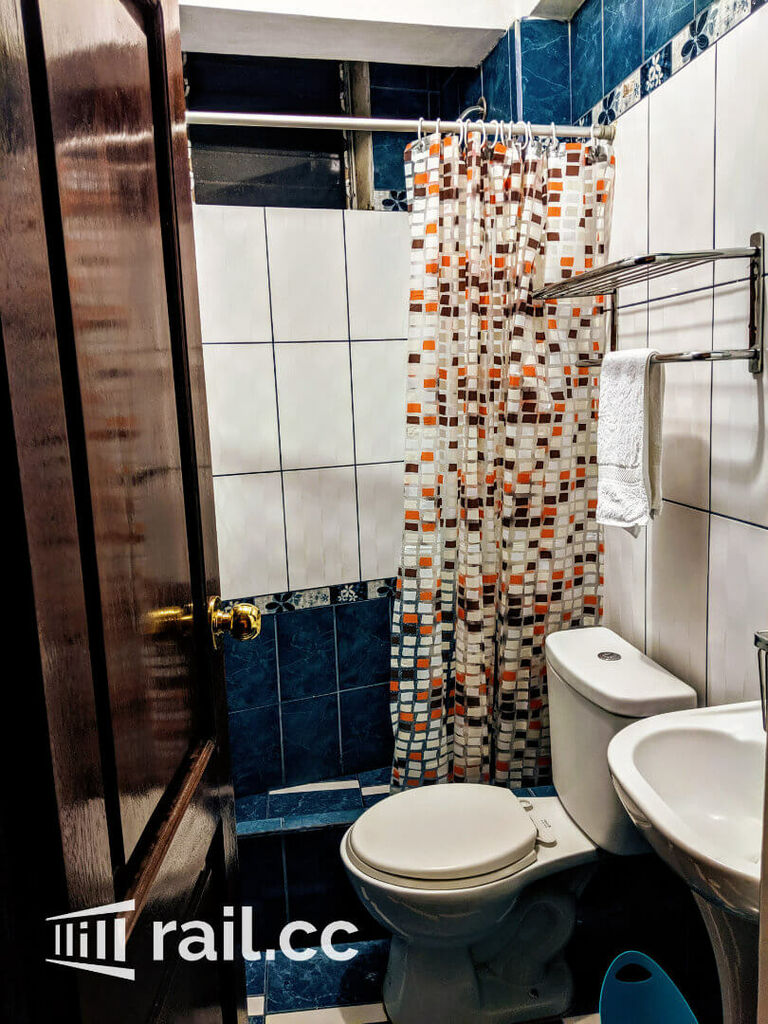
Private bathroom
Visiting Machu Picchu
Before I come to an end, I want to share some tips for the actual visit to Machu Picchu.
If you know far in advance, when you will be in Aguas Calientes, I recommend booking the time ticket to Machu Picchu as early as possible online. The first tickets of the day at 6 am usually are sold out weeks in advance. You can still get tickets for a later entry at 7, 8 or 9 a few days in advance. But the general rule is: the fewer people, the nicer it is up there.
If you want to avoid an early morning ordeal of about one million steps within the ankle-break-territory, you can invest $12 in a bus, which will get you there without much hassle. A return journey costs $24, by the way, and the tickets can be purchased at the bus ticket office, which is very easy to find. It’s best to buy the bus ticket the day before. Please ask the guy at the ticket office, when you will have to be at the terminal (for the 6 am ticket, you will have to get in queue around 1.5 hours before! For later tickets, half an hour before should be fine).
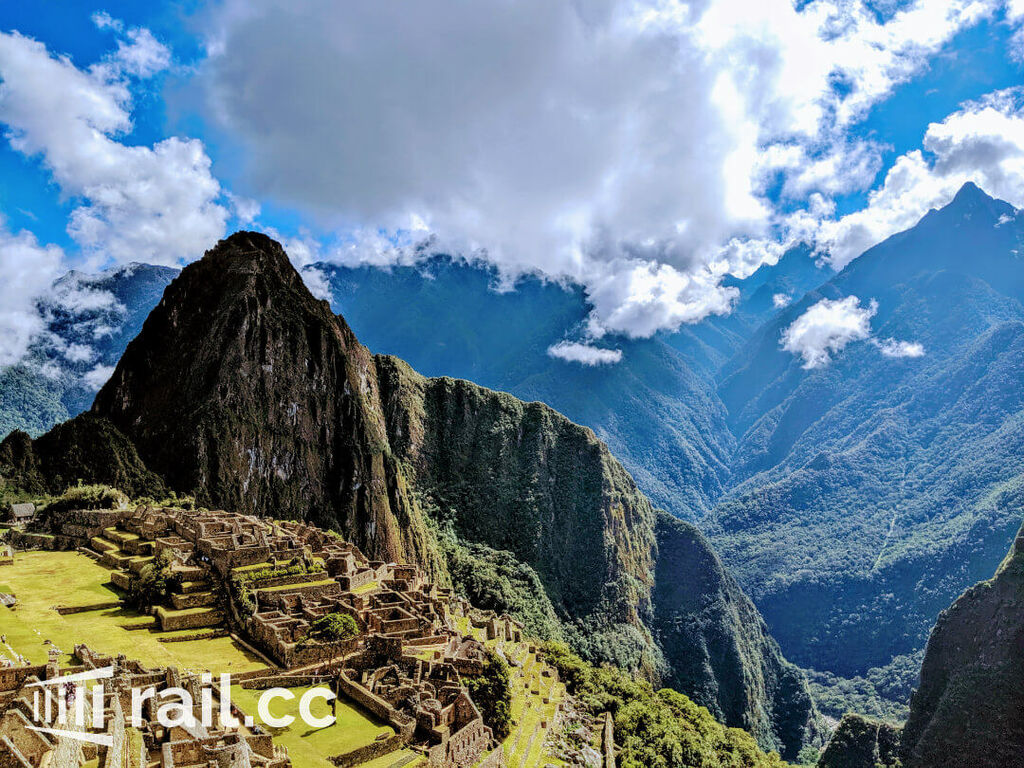
Machu Picchu
And also important: Don’t forget your passport, because you will be able to get a free stamp from Machu Picchu, proving, that you made it to one of the 7 Wonders of the World.
The return journey
There are two possibilities to get back to Cusco. By train, or by yourself. If you opt for a little (and much cheaper) adventure, you can hike along the beautiful train tracks to Hidroeléctrico. The trek takes about 2.5 - 3 hours. Please take enough water and download MapsMe, to not get lost (even if that’s very unlikely). While walking along the tracks, you should always be careful with passing trains. The trek itself is stunningly beautiful and very easy to do. In Hidroeléctrico, you can take a “Collectivo” to Santa Teresa, catch another Collectivo to Santa Maria and change one last time to a Collectivo to Cusco. Travel time is around 7 hours, so it is advisable to leave Aguas Calientes early in the morning. The cost of the whole trip is around €10. You also have the possibility to book a direct shuttle at a travel agency in advance, which will pick you up from Hidroeléctrico and get you to Cusco, which is faster and less of a hassle, but a little more expensive (€25), whereas the trek will still be necessary.
Follow-up-E-Mail after the trip
A few days after my trip, I received an email from IncaRail, asking me, to fill out a review form. As a thank you, I was offered an e-book with pictures and more information about the train journey. Curiously, I filled out the form, sent it, and waited for the e-book that never arrived…
UPDATE: The e-book did eventually arrive, more than 1.5 months after I filled out the form. So you have to be patient ;)
Verdict
What a trip! Stunning landscapes, especially in the observatory wagon. I would go with the 360° any time again since it doesn’t differ much from the Voyager. But I have to say, that the trip altogether is quite pricey and there is no cheap alternative. Also, the friendliness of the train attendants was a bit disappointing, as well as the non-functioning, yet highly advertised In-Train-Entertainment. There are a few things, IncaRail could do better. But: If you’re travelling to Machu Picchu, I warmly recommend you the train trip through Sacred Valley.
Thank you so much for reading! If there are any further questions about choosing a train, the trip to Machu Picchu, etc. you can simply write in our friendly forum, where you will be helped by real travellers.
I planed to publish this blog post on rail.cc. As the community now moved to RailDude, my post is now here. :)
Posted 4 years ago

Ninja
Traveller
0 comments